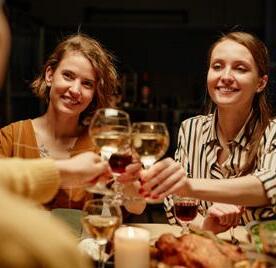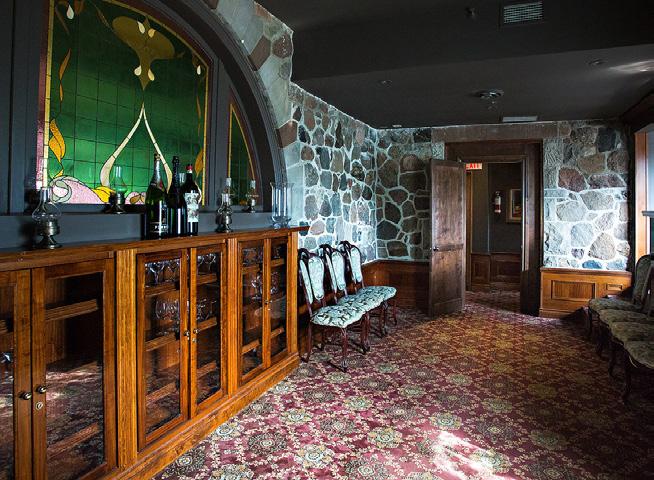PAGES
ARTS, BUSINESS AND MORE!

PAGES
ARTS, BUSINESS AND MORE!






Niagara Regions Premier Event Property. When your wedding, corporate event, or special gathering has got to be memorable, don’t settle for ordinary. Dream a little.
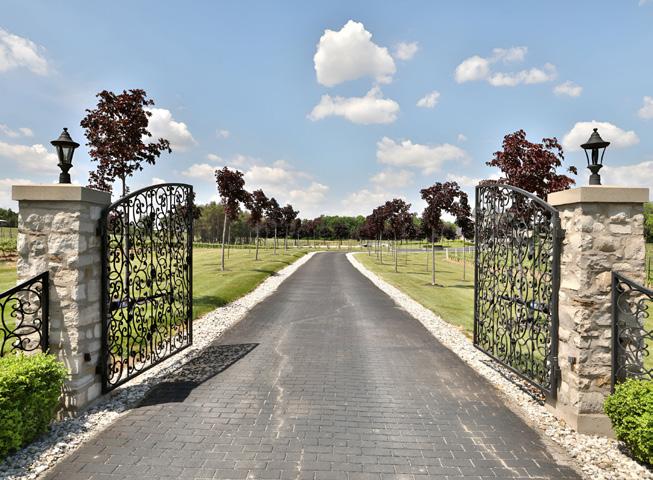



PUBLISHER
JEFFREY MARTIN jeff@hamiltoncitymagazine.ca
ASSOCIATE PUBLISHER + EDITORIAL DIRECTOR
MEREDITH M acLEOD meredith@hamiltoncitymagazine.ca
CREATIVE DIRECTOR
WILL VIPOND TAIT will@hamiltoncitymagazine.ca
EDITOR
MARC SKULNICK marc@hamiltoncitymagazine.ca
SALES DIRECTOR CATHY MILLAR cathy@hamiltoncitymagazine.ca
FINANCE DIRECTOR
GORDON MUISE accounting@hamiltoncitymagazine.ca
HAMILTON CITY Magazine (HCM) is published by Hamilton City Publishing Inc. All rights reserved. Contents may not be reprinted without written permission. ©2023 Hamilton City Publishing Inc.
HCM is a member of Magazines Canada. HCM basic price: $39 (HST includedsix issues). Single copies: $7.95 (plus HST).
HCM (ISSN 2816-7449) is indexed in the Canadian Periodical Index. Printed in Canada by St. Joseph Communications. HCM is distributed by Canada Post.
Contact Us: 270 Sherman Av N, Studio 301 Hamilton, ON L8L 6N4 info@hamiltoncitymagazine.ca hamiltoncitymagazine.ca
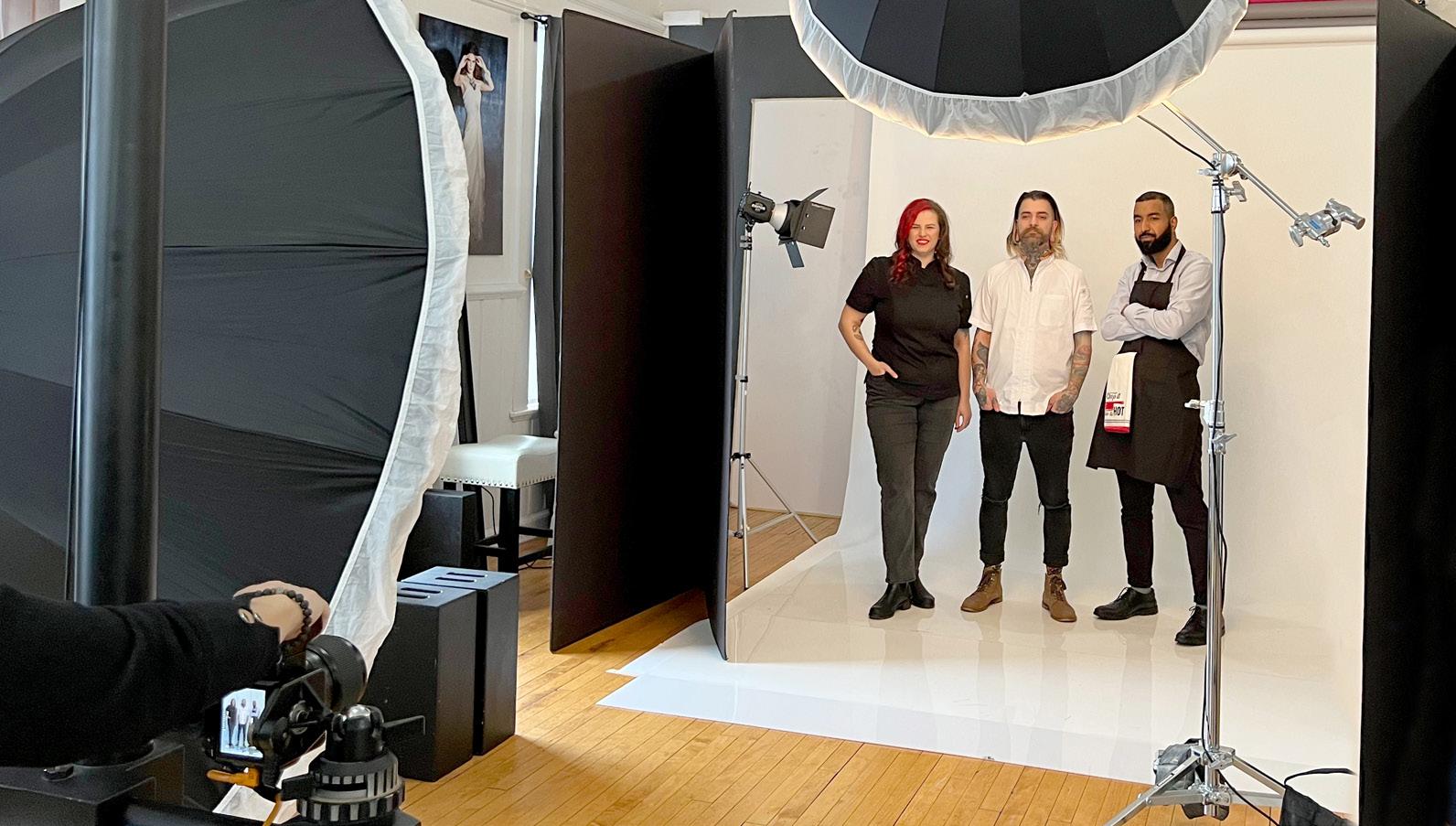
Don’t look now but there’s a definite buzz around Hamilton’s burgeoning food and drink scene, from the city’s ever-expanding craft brewing industry to the continued emergence of world-class restaurants in the core, it’s clear that Hamilton can give our big-city neighbours a run for its culinary money. No matter your craving, chances are there’s a restaurant or brewery that will satisfy and HAMILTON CITY Magazine’s Food & Drink issue celebrates the food makers and drink shakers that call Hamilton home. We are so excited to be able to showcase seven amazing chefs who are not only putting the city on the culinary map but making Hamilton a diverse city for great food. We hope you agree that Elaine Mitropoulos’s article not only highlights seven fabulous chefs but also celebrates these talented individuals who are contributing to their community in so many different ways. We’re also equally thrilled to be able to tell Matty Cowan’s inspirational tale. Cowan is the culinary mastermind behind beloved Hamilton restaurant The Heather that became a foodie fixture on Barton Street. Like so many eateries, it was affected by the pandemic and was forced to close. Vanessa Green’s feature looks at Cowan’s culinary comeback and how he found the inspiration and motivation from an unlikely source. Sometimes in life that’s all it takes to tip the balance in your favour and, once
again, The Heather is wowing local foodies, but this time from a new location on Locke Street South. And speaking of wowing local foodies, we’ve also enlisted Jody Aberdeen to take a deep and delicious dive into the Hamilton-Burlington area’s ethnic offerings: whether you’re into Indian, Greek, Persian, Peruvian, Thai, African, Mexican or Syrian, you’re quite literally spoiled and we’ve compiled a list – by no means definitive –of some of our favourite restaurants serving up all manner of global cuisine.
And when you’re done feasting, Heather Peter has you covered for local chocolatiers that are as decadent as they are delicious –so if sugary treats are your guilty pleasure (life’s too short for it not to be), Heather will do your sweet tooth justice. Did we mention there are also articles on breweries, farms, mustards, jams, hot sauces and … well, you get the picture. Our food & drink issue is a veritable cornucopia of fun and informative features on everything to do with eating and drinking – Hamilton style.
So on that note, we’ll simply invite you to dig in to this edition of HAMILTON CITY Magazine. As always, we welcome your feedback about our publication. Tell us what you like and what we can do better. We’re constantly striving to make our magazine and website better and we can’t do it without you! n
Jeff, Meredith, Marc, Will, Cathy & Gord
18/ SWEET AND SPICY
Hamilton is home to a pair of iconic companies that are as delicious as they are historic.
31/ A DELICIOUS COMEBACK
Matty Cowan’s The Heather got a second chance at success thanks to an unlikely source of inspiration and collaboration.
34/ CHOCOLATE FOR THE WIN
A wise man once said that ‘life is like a box of chocolates, you never know what you’re gonna get’ and in that regard, the Hamilton-Burlington area has no shortage of Gump-worthy decadence.
38/ A CULINARY CULTURE CLUB
Diverse flavours are alive and cooking in Hamilton and we’re profiling seven chefs who are putting the city on the foodie map.
48/ DIVERSE AND DELICIOUS
No matter what you’re craving and no matter what country it may be from, chances are you can find it locally.
56/ TRUE LOVE FOR TRUE NORTH
Waterdown gallery is a hidden gem that boasts works of art from some of music’s most iconic names.
60/ WEIRD SCIENCE
When it comes to making music, Cadence Weapon can do what he wants – and make it as weird as he wants.

TIME AFTER TIME
With the closure and impending demolition of the h amilton c ity c entre, the historic clock that has to W ered over the corner of york and James W ill face an uncertain future. i ts past, ho Wever, is as storied as it is fascinating.

The City of Hamilton is situated upon the traditional territories of the Erie, Neutral, Huron-Wendat, Haudenosaunee and Mississaugas. This land is covered by the Dish With One Spoon Wampum Belt Covenant, which was an agreement between the Haudenosaunee and Anishinaabek to share and care for the resources around the Great Lakes. We further acknowledge that this land is covered by the Between the Lakes Purchase, 1792, between the Crown and the Mississaugas of the Credit First Nation.
Today, the City of Hamilton is home to many Indigenous people from across Turtle Island (North America) and we recognize that we must do more to learn about the rich history of this land so that we can better understand our roles as residents, neighbours, partners and caretakers. Both the National Day for Truth and Reconciliation and Orange Shirt Day take place on Sept. 30 and recognize that at least 150,000 Indigenous children from across the country were forcibly separated from their families and their communities.
Whether buying or selling, we offer uniquely local expertise with world-class service.
Whether buying or selling, we offer uniquely local expertise with world-class service.
As a Hamilton-based full-service real estate team, we are ready to help with your next purchase, sale or investment. Let’s talk.
As a Hamilton-based full-service real estate team, we are ready to help with your next purchase, sale or investment. Let’s talk.
Martinus Geleynse Senior Vice President, Sales, REALTOR®Martinus & Associates
905.537.4819
Martinus GeleynseSenior
Vicewww.martinus.ca
President, Sales, REALTOR®
Martinus & Associates


905.537.4819
www.martinus.ca

If you like the idea of camping but don’t actually like the part that involves sleeping on the ground in a tent, the good folks at the Hamilton Conservation Authority have just the solution. They recently announced that the popular Valens Lake Conservation Area now has eight delightfully rustic cabins available to rent, all year round. In case you’ve been living under a rock, Valens Lake in Flamborough is a 300-hectare mecca for campers, hikers, anglers, and outdoor lovers alike and boasts more than 10 kilometres of hiking and walking trails, 225 camp sites and a picturesque swimming area complete with sandy beach. With the launch of the all-season Drumlin cabins – with names like Canada goose, swan, owl and loon – camping
has become glamping and while not quite five-star accommodations, the new cabins can sleep as many as six people and come in three layouts, complete with kitchenette with sink and fridge, mattresses, flush toilets, propane BBQ and baseboard heating so you can keep warm during the winter months. In addition to being located in a stunning conservation area overlooking the lake, all the cabins feature pine walls, ceilings, and log furniture for that authentic “great outdoors” vibe. Rates start at $135 (plus HST) a night and there’s a two-night minimum with a 14-night maximum. Dogs are not allowed, nor is alcohol and you must be 25 years old to book. For reservations, visit conservationhamilton.ca/cabins n
DOUG FORD PROMISED ONTARIANS THAT THE GREENBELT WAS OFF-LIMITS TO DEVELOPERS – ONLY TO GO BACK ON HIS WORD. THE ABRUPT POLICY SHIFT HAS ENRAGED MUCH OF THE POPULACE AND AS RYAN Mc GREAL POINTS OUT, FORD LOOKS TO HAVE ONE HECKUVA FIGHT ON HIS HANDS.
On June 2, 2022, Doug Ford and the Ontario PC party won a majority of seats in the Ontario legislature with the support of just 18 per cent of eligible voters. His party didn’t release a platform, his candidates strategically refused to participate in local riding debates, and he held almost no media engagements. Overall turnout was just 43.5 per cent, the lowest in Ontario’s history. The PCs received 40.8 per cent of the vote but won 67 per cent of the seats.
Ford benefited from widespread public exhaustion and burnout from the pandemic,
combined with weak competition in a Liberal party weighed down by an unknown, uncharismatic leader, and a New Democratic Party that seemed more interested in fighting for second place than presenting a compelling case to lead the province.
Ford’s promise to Ontarians was to “get it done” – but he was assiduously vague about what “it” might be. I wonder if he would have won if voters knew he was planning to break his promise to protect the Ontario Greenbelt from development.

The Greenbelt is a vast area of environ-
mentally sensitive farmlands, wetlands, grasslands, forests, watersheds and other greenspace in southern Ontario that was legally protected from development under the Greenbelt Act in 2005.
Ford has had a difficult relationship with the Greenbelt. In 2018, he publicly promised to protect the Greenbelt. Then video surfaced of Ford telling a private roomful of developers that his plan for “affordable housing” was to “open up … a big chunk” of the Greenbelt to let them build on it – and that it was developers who gave him the idea.
The backlash was instant and intense, and Ford quickly backtracked, insisting “the people have spoken” and that he would protect the Greenbelt after all. In 2020, he reiterated his promise not to touch the Greenbelt amid public outrage over changes to the law governing conservation areas that weakened their oversight powers.
During the 2022 campaign, to the extent that he spoke to the media at all, Ford repeatedly promised that he would not touch the Greenbelt. But last November, just five months after the election, he announced out of the blue that the Ontario government would strip 7,400 acres from the Greenbelt to allow new development – including 1,900 acres of protected lands in Hamilton.
This abrupt policy shift was not based on public sentiment. Indeed, the government’s own public consultations on the announcement found broad and consistent public opposition to removing Greenbelt protection.
But there was one demographic cheering the policy shift: the handful of property developers who are major donors to the PC party and who own most of the properties and would profit massively from their rezoning to allow development.
Investigative reporters soon discovered the property owners had been quietly buying it up over the past few years – the most recent purchase was just weeks before the announcement – raising questions about whether they knew the change was coming. When Municipal Affairs Minister Steve Clark was asked directly during Question Period if the developers were tipped off about the policy change, he flatly refused to answer.
Ford insists he needs to carve out the Greenbelt to provide more housing, but just this past February, his own government’s housing affordability task force concluded, “Most of the solution must come from densification” and the “Greenbelt and other environmentally sensitive areas must be protected.”
Both the Ontario integrity commissioner and the auditor general have opened investigations into the decision, while the OPP’s
anti-rackets branch is reviewing whether to open an investigation.
The Ford government’s shameless Greenbelt flip-flop comes amid a furor over Bill 23, the More Homes Built Faster Act, which, in typical Ford fashion, drowns a sensible idea or two in a flood of shameless giveaways to politically connected developers.
First, the good stuff. Bill 23 requires municipalities to allow up to three units on a residential lot as-of-right without a zoning variance. This will make it easier to add accessory suites like garden or laneway housing or basement apartments, and recognizes that single-unit zoning is just inherently exclusive and wasteful of valuable land.
However, it also strips conservation authorities of the power to protect rivers and wetlands from harmful developments that raise the risk of flooding; slashes the development charges that pay for new municipal infrastructure, which forces cities to cover the balance from the existing tax base; and prohibits site plan controls that can make new developments more environmentally sustainable.
Compounding these disastrous policy changes, Ford also overturned Hamilton’s firm urban boundary policy, a huge victory for local democracy when Hamiltonians across the city overwhelmingly told council to protect Hamilton’s greenspace and focus on building up rather than out.
Instead, the province has ordered Hamilton to expand its urban boundary by a massive 5,400 acres, a decision that has already provoked multiple demonstrations and a request by Environmental Defence for a judicial review on the basis that it violates the province’s own planning and growth policies.
Once sensitive natural lands have been de-
In 2018 , he publ I cly prom I sed to protect the Greenbelt. t hen v I deo surfaced of f ord tell I n G a pr I vate roomful of developers that h I s plan for ‘affordable hous I n G ’ was to “open up … a b IG chunk” of the Greenbelt to let them bu I ld on I t –and that I t was developers who G ave h I m the I dea.
stroyed, they are gone forever. This series of policy changes is mindbogglingly short-sighted – a catastrophic abrogation of the provincial government’s sacred duty of care for our common heritage in order to supply easy profits for its donors.
Local organizations Environment Hamilton, environmenthamilton.org and Stop Sprawl HamOnt (ssho.ca) are teaming up to organize resistance. Contact them and ask what you can do to help. n


FOR THE LOVE OF HAMILTON: BURLINGTON EDITION! THIS REGULAR FEATURE WILL HIGHLIGHT PEOPLE, FROM ALL WALKS OF LIFE, WHO HAVE EMBRACED THE GHA AS THEIR NEW HOME.
who she is: Dog-mom and communications specialist

interviewed by:
Will Vipond Taitphoto by: @pureandlovelyphotography
hamiltoncitymagazine.ca
scan the qr code to read the full q+a online.
CARLY HOLMSTEAD is a dog mom, a passionate musician, and a communications specialist for an industry association. She recently returned to her hometown of Burlington and is newly appreciative of all it has to offer – especially its small-town vibe combined with big-city amenities.
What attracted you to move from Paris to Burlington?
I grew up in Burlington, so the idea of moving back here was easy. I had family and friends around me and I loved the convenience of the city. Ironically, I spent my entire teenage years wishing I could leave Burlington, and don’t get me wrong, I loved experiencing a new city and feeling the small town life, but I missed the accessibility of Burlington. I always loved all that Burlington has to offer. There is access to any amenity you could need, including Toronto, but drive just a little outside the city and you can be in full nature.
What neighbourhood do you live in, and why did you choose it?
I am in the Palmer neighbourhood. When I started looking at places, I was set on a totally different neighbourhood, and to be honest, I never really knew this area existed. I drove past it all the time growing up, played hockey around the corner, but I never ventured into the area. The first time I viewed my house I knew I wanted to live here. The neighbourhood is filled with young families – and tons of dogs – who take so much pride in their ownership. Plus, it really is central to everything in the city. I am minutes from the 403, downtown core, malls and restaurants, GO station etc. I never have to go far to find what I need.
What do you love best about Burlington?
This is such a niche answer, but there is one restaurant in Burlington that does celiac-friendly, gluten-free bar menu items on Mondays. To be honest, it’s such a hidden gem for the celiac community, and conveniently, it’s quite literally a two-minute walk from my house.
However, if I answer this question more seriously, I would say the small-town feel with big-city amenities. It’s really fun to see so many generations who have attended the same school as their parents or played in the same sports league. I feel like you will always know someone, or have a connection with someone, in that way, that feels really special to me.
Oh yeah, the restaurant is the Judge and Jury for my celiac friends!
Have you had a chance to explore Hamilton yet and if so, what did you find?
Admittedly, not enough. My favourite bakery, Fairly Frosted, is in Hamilton so I make a trip there from time to time, but, honestly, I should explore it more. I hear the restaurant scene is amazing, so that’s something I have always wanted to explore. Maybe a summer bucket list item!
Tell us about your dog and where is your favourite place to walk her?
Oh, Phoebe! She is such a dork. Her personality is truly that of a Great Dane. She is clumsy, cuddly and so, so sleepy. Lately, my favourite place has been downtown Burlington by the water. I love being near water and in nature, so it really is such a perk to have that just minutes from my house. n
READ WHAT ELSE CARLY HAS TO SAY about Burlington and more, exclusively online by scanning the QR code.
If you’d like to be featured in FOR THE LOVE OF HAMILTON, please contact meredith@hamiltoncitymagazine.ca
Late in 2022, the doors of Hamilton’s City Centre were closed permanently. In the clock tower, the property’s historic time piece came to a stop, and it will soon be put into storage. This clock first saw James Street over 130 years ago and when it returns, inside a new urban development, the view will have changed dramatically.
The clock first appeared in 1889 at the corner of James and King William streets atop a stone tower at Hamilton’s new City Hall. Its bells rang over downtown for those who couldn’t see the clock face but still needed to know the time.
Back in the day, watches were not common. People relied on the clock tower to be on time for work, to meet friends, or catch a ride on the new transit system on James Street. Starting in 1892, the electric trolley swooped along at an impressive six miles an hour, a big change from the horse-drawn trolleys.
The clock’s view took in the CNR station a few blocks away, now known as LIUNA Station, where many immigrants first arrived in the city. The population grew to 79,000 in 1901; 190,000 in 1931; and 266,000 by 1951. But despite there being more citizens, downtown Hamilton was not thriving as it had in earlier eras. One theory about this trend was the increase of automobiles drawing people to the suburbs and altering neighbourhoods for the benefit of vehicles, not pedestrians.
In a move to make downtown Hamilton more vibrant again, city council implemented a contentious urban renewal of epic proportions. Properties on each side of King Street were expropriated and demolition followed to make room for modern buildings throughout the city core. The fact that many heritage buildings came down was a disappointment that is still discussed, and lamented, today.
As City Hall aged, there were calls for its removal to make space for new commercial enterprises on James Street. And in 1961, down it came, along with its clock tower, after a new City Hall was built on Main Street. The
demolition was carried out by Eaton’s, the new property owner, which wanted to build an expansion to its department store next door. The city hall clock and bells went into storage and wouldn’t be seen for another 30 years.
During that time, the clock tower’s whole block – bounded today by Bay, York, James and King – was completely changed. Jackson Square opened in 1972; the Central Library and current Hamilton Farmers’ Market came along in 1980; Hamilton had a new convention centre in 1981; the Standard Life Centre came in 1983; and both the Sheraton Hotel and Copps Coliseum opened in 1985.
It wasn’t until the late 1980s that the new Eaton Centre was built with the historic clock and bells in the modern tower that we see today on James Street. Unlike the original clock tower placed at the intersection of King William Street, the new one was further north on James.
Sadly, Eaton’s was in business only for another 10 years before its shopping centre in Hamilton was one of many that closed across the country. With Hamilton City Centre as its new name, the property ownership would change several times, but the appearance and function remained much the same.
Until now.
The property’s new owner, IN8 Developments, will demolish the current buildings to make way for a major redevelopment with four large condo towers as well as commercial space. There will also be many new pedestrian areas and this is where the historic clock will make a comeback in several years.
The clock’s view will surely be much different when it returns. Unlike its perch at old City Hall, the electric trolleys are gone but there will be lots of electric vehicles. And since the Eaton Centre days, the clock might notice that James Street has gone back to being two-way. Most of all, if everything goes to plan, there will be lots of people walking about in a setting that seeks to prioritize pedestrians over vehicles, similar to earlier times in our downtown. n
In 1929, Henry Birks and Sons opened a store on the southeast corner of King and James. Outside of the building’s second floor, a beautiful and massive clock hung over the sidewalk. Standing 18 feet tall and weighing one ton, it was built in England as a replica of a popular 14th-century clock. Birks was a popular meeting spot to watch the clock’s animated knights chase each other at each quarter hour and listen to its 200 songs.
When Birks moved into Jackson Square in 1972, its old building was demolished, and the clock went into storage. In 1986, it was installed outside the mall’s main entrance but when it stopped working, the clock returned to storage in 2007.
In 2011, the Hamilton Farmers’ Market on York Boulevard was renovated and became the home of the newly restored Birks clock, also known as the Clock of the Charging Horsemen. Today, you can still watch the horsemen charge around the clock, forever to miss each other, yet always entertaining.

WITH THE CLOSURE AND IMPENDING DEMOLITION OF THE HAMILTON CITY CENTRE, THE HISTORIC CLOCK THAT HAS TOWERED OVER THE CORNER OF YORK AND JAMES WILL FACE AN UNCERTAIN FUTURE. ITS PAST, HOWEVER, IS AS STORIED AS IT IS FASCINATING.
Support Hamilton’s craft beer scene while letting someone else do the driving on a guided tour by Redback Tours. Like the pub crawls of yesteryear, but with an elevated twist that’s easier on the feet, the monthly excursions, held in a luxury minibus, or van take guests on a five-hour outing to a selection of local breweries and cider houses. In addition to samples and snacks, participants will enjoy some behind-the-scenes intel into Hamilton’s brewing brewery industry. Have a bunch of thirsty friends and some time to spare? Redback also offers private tours for a memorable bonding experience – a great alternative to waiting in line for a brunch table. redbacktours.ca
One of Hamilton’s surest signs of spring is when a plethora of runners emerge to take part in the annual Around the Bay Race, the oldest road race in North America. Since its debut in 1894, the event has attracted many of the finest long-distance runners in the world, as well as many of your sporty neighbours, with everyone trying to see what they are made of – athletically speaking. Virtual races are still on the docket, but nothing compares to the thrill of an in-person race on the 5K and 30K routes, where the excitement generated from watching from the sidelines can give even the spectators a runners’ high. March 26 bayrace.com
If you’re looking for a new way to expand your road-racing repertoire this spring, be a trailblazer and sign up for the first annual Her Majesty’s Royal Races. With proceeds going towards the Army Cadet League, you’ll be helping support Hamilton’s youth while enjoying a heart-healthy day on the 3K and 5K routes, where both runners and walkers are welcome. Come for the race, but be sure to stay for the snack, where the royal theme continues. In addition to all registrants receiving their own Paddington Bear in their race kit, the post-event lunch features marmalade sandwiches and a wee spot of tea. April 23, Royal Hamilton Yacht Club raceroster.com
When it comes to dance lessons, the kids shouldn’t have all the fun. Perfect your rhythm, up your fitness and have a ball as you learn tap dancing basics at Eleva8 Dance Studio’s classes for adults. As your feet learn how to shuffle, ball-heel, and then put the two moves together in the aptly named shuffle ball-heel, you’ll revel in the fact that the even sounds created by muddling through the moves sound kind of cool. Tapped out? Check out the website for other classes offered in hip hop, jazz and ballet. elev8danceinc.com
The lengthening spring days means there’s more time to commune with nature on the regular, so be sure to allot some time to visit the Royal Botanical Gardens for its spring-themed family fun day. Gather your crew and join a guided nature walk for a close-up tour of the Arboretum, and see the magic created by the warmer days in the form of blooms, buds, and likely some bugs (be warned). The resident birds will be sure to provide an upbeat soundtrack as you wander the gardens, breathing in the unique feeling of hope a warm spring afternoon creates. April 22 2 p.m.-4 p.m. rbg.ca
A new parent can only push that stroller so far before they just need to sit down for a sec. When you’re ready to take a break, stroll on over to Grain and Grit brewery for a parent meetup that has more to do with building a community than it does beer. Already a parent- and baby-friendly space, Grain and Grit’s twice-weekly parent meetup events offer new parents a chance to enjoy a refreshment (beer optional) while venting, laughing and connecting with other folks who won’t give that crusty stain on your shirt a second thought. Tuesdays, 2 p.m.-4 p.m. and Thursdays 12 p.m.-2 p.m. grainandgritbeer.com

The days are getting longer and the weather is getting warmer, which means getting out and about the city is a great way to embrace all that spring has to offer. With that in mind, here are a few of our favourite local happenings guaranteed to put a smile on your winter-weary face.
In the last municipal election campaign, the issue of safer streets was a common theme across neighbourhoods city-wide. Residents told many candidates that they didn’t feel safe walking in their communities because vehicular traffic was creating a dangerous environment for pedestrians.
This impacts all members of the community including kids, many of whom make the trip to and from school each day. Some of these kids walk or wheel to school, but many others make the trip by car due, in part, to the unsafe environment.
In fact, fewer and fewer students are walking or cycling to school. From 1986-2011, the rate at which Greater Toronto and Hamilton Area (GTHA) students 11-13 years of age were driven to school doubled, according to a Metrolinx study. At the same time, the percentage of children walking and cycling fell from 62 per cent to less than half. Today, this problem persists, as more recent data shows that less than 40 per cent of students in Hamilton are using active transportation (walking, cycling, etc.) to get to school.
Using active transportation to get to and from school has numerous benefits to a child’s health in both the short and long term.
First, active transportation helps kids reach the recommended 60 minutes of daily physical activity. Second, walking to school prepares the brain for learning by improving alertness, attention, and motivation.
As a result, walking to school is associated with better academic performance. Third, when a child walks or bikes to school, they arrive at school feeling less stressed, which allows them to interact with others and learn new things more easily. Fourth, active transportation exposes children to morning sunlight, which is one of the key pieces of information that our body uses to regulate our energy levels. Fifth, walking to school connects children with their neighbourhood and gives them an opportunity to develop key independent life skills like navigation and arriving at a destination on time. Finally, studies show that allowing children to
engage with each other in unstructured settings, such as the walk to school, promotes creativity, problem-solving, and positive emotional development.
From a broader community perspective, active school travel reduces the number of car trips taken, which has environmental, social and economic benefits, including less carbon emissions and reduced wear and tear on our roads.
So what can we do to boost active school travel rates?
To start with, we need to understand that there are many different but connected issues affecting the decision to walk/wheel to school. For example, traffic safety, street design, cycling networks, family schedules, public awareness, distance to school all come into play. What is required is an approach that reflects this reality.
Since 2020, a program called the Daily School Route (DSR) has been working to address this. The DSR is an approach to active school travel that looks at the issue differently. The DSR sees kids as “transpor-

STUDENT STREETS HELP TO CREATE SAFER, HEALTHIER NEIGHBOURHOODS AND THAT BENEFITS EVERYBODY, SAYS URBAN PLANNER PAUL SHAKER .
tation users” within their own system and creates a network of routes, called Student Streets, to help facilitate safe and effective active school travel. These Student Streets are contiguous routes to school that should be designed to be safe, convenient, and attractive for elementary school students to use for active transportation. Students are inventive in how they travel, frequently taking the most convenient route for them. In many neighbourhoods, this can mean venturing away from the roadway and using other facilities like parks, alleyways, and neighbourhood cut-throughs. Students connect these different land uses with their routes to school.
The goal of the DSR is to see 100 per cent of students who live close enough walking or wheeling to/from school daily, regardless of age, ability, or personal circumstance, so that they can experience the benefits of active transportation. So far, the Daily School Route has been introduced at 25 schools across Hamilton and, with support from the Patrick J. McNally Foundation, engagement with elementary schools significantly increased during the 2021-2022 school year. You may have seen some DSR street signs around your neighbourhood as more and more Student Streets are implemented.

So what has been learned so far? Based on engagement with almost 1,500 families across participating elementary schools, data indicates that only 39 per cent of respondents use active transportation to get to school, despite 64 per cent of them living within 1.6 kilometres of school, and thus not eligible for busing. Meaning, hundreds of these families do not use active transportation to get to school despite being deemed close enough by our school boards’ transportation bodies. If we scale these numbers to Hamilton’s entire elementary school population, there are thousands of students in Hamilton who could be using active transportation but are not.
The DSR has also been able to learn about the effectiveness of current safety measures. For example, the existing approach to creating a safer pedestrian environment around schools involves the creation of school safety zones that are identified within 150 metres of a school boundary. Inside this zone, speed limits are reduced to 30 kilometres per hour. While this helps make the environment immediately around a school safer, it doesn’t
reflect the reality of the full walking trip to school. DSR data confirms that many students are walking/wheeling from distances beyond 1 kilometre. Thus, in order to be effective, these zones need to be expanded to match the distances students are actually walking.
The speed of traffic is another very important factor at play. Respondents to DSR engagement frequently cite speed and unsafe streets due to traffic as a top reason for why they currently don’t walk to school. Further, they cite speed reduction as a priority change that would encourage more active transportation. As it turns out, transportation research backs up these concerns. Research from the Organisation for Economic Co-operation and Development (OECD) demonstrates that if hit at
50 km/h there is a very high likelihood of a pedestrian fatality. Comparatively, at 30 km/h the chance of death is 10 per cent. Other research shows that as impact speed increases past 30 km/h, risk of severe injury increases. Therefore, reducing speed limits by 10 km/hr in areas concentrated with vulnerable populations, such as school zones, significantly reduces the risk of serious injury and fatality.
The good news is that speed limit reductions and the size of school safety zones are tools entirely within our control as a community, so there is nothing preventing us from designing our neighbourhood streets with an understanding of the full trip to school in order to create routes for students that are safe.
Building on early momentum, the DSR has expanded its approach to look at an entire city ward, which is a more effective way to capture information about the active school travel environment among several schools that are geographically co-located. With routes identified for several schools at once, necessary safety improvements are flagged to make the Student Streets safe, convenient, and attractive. When combined with wardwide improvements, such as speed limit reductions, what results is a ward strategy to create safer streets for all residents.
At the core, that is what this is all about. While the goal of the DSR is to get more kids walking and wheeling to school on a daily basis, at the end of the day, we are striving for more family-friendly community planning that encourages healthy lifestyles. An elementary school is typically a centrepiece of a neighbourhood and it becomes a focal point for travel twice a day for children and parents. Thus, how well streets are functioning for the trek to school is a good indication of how well the streets are functioning in general. Moving forward, school communities should be more involved in the planning of the neighbourhoods in which they are located. This would lead to more holistic, safe and healthy neighbourhoods over the long-term, benefitting all community members.
active school travel reduces the number of car trips taken, which has environmental, social and economic benefits.
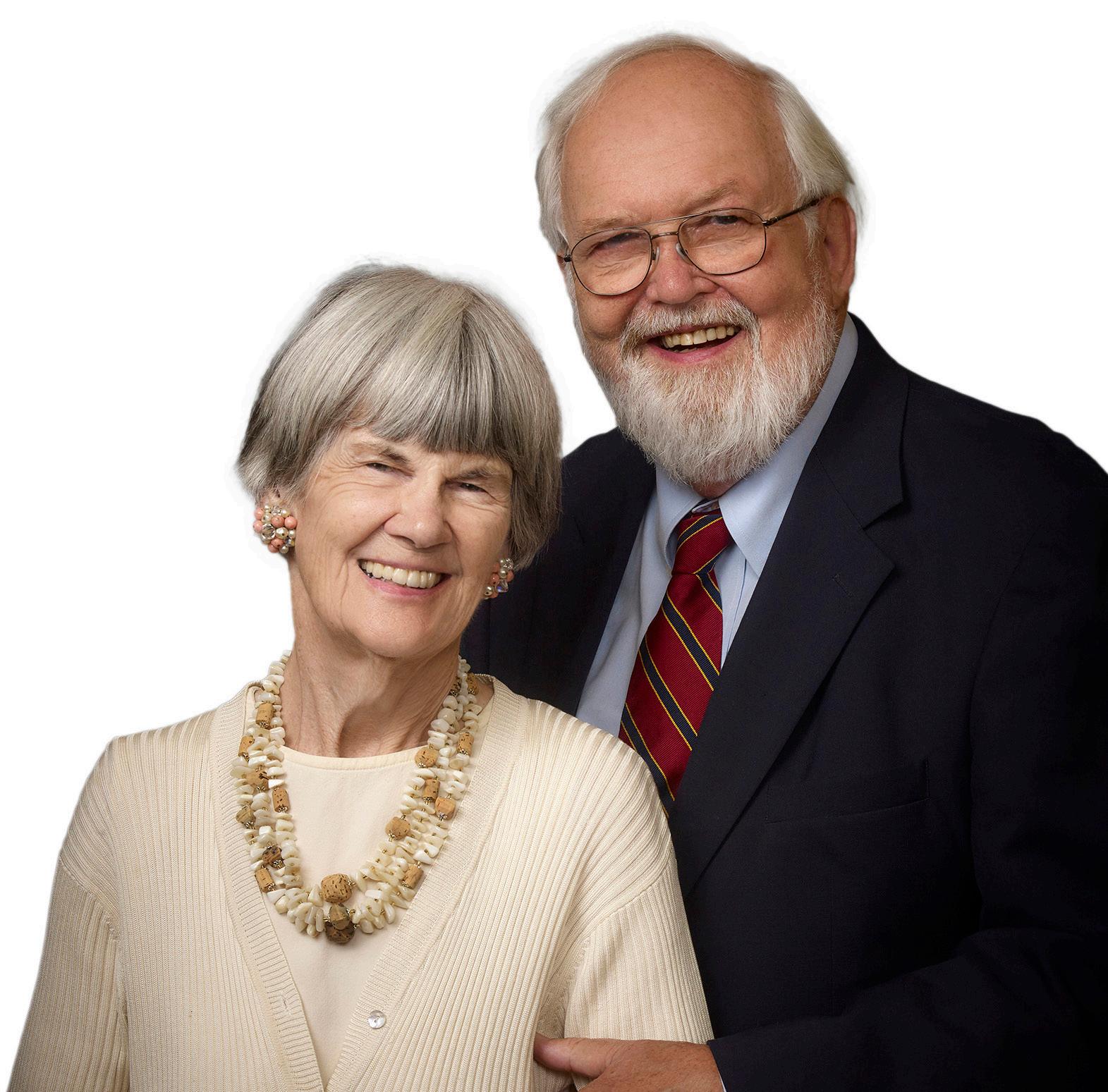
Carl and Kate Turkstra never sought the limelight as they quietly supported Hamilton arts organizations big and small.
Founders of the Incite Foundation for the Arts, the Turkstras believed the arts are key to quality of life and critical to the future of Hamilton. And they believed anyone, regardless of circumstance, should be able to enjoy and pursue music, theatre and visual art.

Hamilton lost tremendous patrons in Carl, who died May 22, 2022 and Kate, who joined him on Jan. 21, 2023.
But their legacy carries on in Incite, which since its founding in 2011 has contributed more than $5 million to 30 Hamilton-area organizations in grants from $2,500 to $150,000.
They did much more than sign cheques. Kate and Carl sat on boards, they bought art, they attended performances and they convinced others to get involved.
“Dad grew up in Hamilton and he was very devoted to Hamilton and the fantastic people doing fantastic things in the arts,” says daughter Jen Turkstra..
Carl is credited for leading the charge that saved the Hamilton Philharmonic Orchestra when it faced bankruptcy.
“There is no question he saved the HPO, but Carl would never tell you that,” says Graham Crawford, a friend of the Turkstras and a member of Incite’s advisory committee.
“He applied his business skills to the organization and he convinced others to step in and work, too. They were true, old-style philanthropists. They didn’t want credit, they wanted results and to make an impact.”
Carl was also critical to the creation of a new home on James Street North for Hamilton Artists Inc. and he stepped in to make the restoration of the Westdale Theatre a reality.
Peter Turkstra says his parents developed a keen appreciation for the power of the arts in the cities they lived in, including London, Brooklyn, Mexico City, and Montreal, during Carl’s illustrious career as an engineer and university professor.
“So they saw the opportunity within Hamilton, that its wonderful arts community could affect the city in a positive way. Dad’s mantra was that it was your duty, as a successful person, to give back. He always had an eye for the underdog and he sought to help those who were being overlooked.”
Carl admired the entrepreneurialism, sacrifice and grit of artists, says Peter, and while he may have been the driving force, Kate was equally committed to Incite and its capacity to grow the arts in Hamilton.
The Turkstras especially liked to support arts programming for children, including providing free passes to the Art Gallery of Hamilton and donating to An Instrument for Every Child and the Hamilton Children’s Choir.
“They particularly loved to go see children perform. Carl would cry every time,” says Liz Stirling, administrator of Incite.
“There are so many stories of Carl’s gen erosity and I am sure there are many I don’t know. He wanted no recognition for what he did.”
Carl and Kate came into their wealth after Carl returned to Hamilton at the request of his father to take over Turkstra Lumber in 1989. It was struggling in the midst of a recession but Carl was able to turn things around before retiring in 2010 when Peter took over.
Carl and Kate were humble, kind and down-to-earth, says advisory committee member Toby Yull.
“They were wealthy but completely unpretentious and fun. Kate was lovely and kind and had a charming English eccentricity. She saw the beauty in simple things. We found a dining room table and chairs for her home at a second-hand shop at a golf course. Others would have refinished and reupholstered everything, but Kate loved it the way it was.”
That table became command-central for Incite.
Carl directed that the foundation would operate with little administration. His other stipulation: It would not be named after him.
“He flatly rejected any talk of that,” says Crawford, who came up with Incite. Carl loved the multiple meanings and especially that it means to rally others in support of a cause.
“It’s been hard to go on without them, but that’s what Carl and Kate wanted this foundation to do,” says Liz. “It’s such a privilege to carry on with their beautiful legacy to this city.” n incitefoundation.ca
From festivals and films to galas, galleries and gigs, Hamiltonians love to have a good time and these photos are definitely worth a thousand words. HAMILTON CITY Magazine was there – were you?
photos By B rent perniac + Donna Waxman
1. DJ Mark Furukawa, Risky Business ‘80s dance party, Jan. 7.
The 10th annual St. Joseph’s A Mental Health Morning, Feb. 2:
2. Carrie Trembinski & keynote speaker Jesse Thistle 3. Sera Filice-Armenio, April Mansilla & Melissa Farrell.
Come Together! HPO Performs The Beatles, Feb. 11: 4. Bill Dillon & Jay Gordon Wright 5. Ian Thomas 6. Darcy Hepner, Queen Pepper & Jamie Oakes 7. Kim Varian, Darcy Hepner, Larry Paikin & Ian Thomas.
To check ou T more phoTos, scan T he qr code











If the Hamilton Chamber of Commerce ever wants to put on a large-scale, world-class event, they’ll be in good hands with Greg Dunnett at the helm. The newly appointed president and CEO of the chamber has an impressive number of sports teams and big games on his CV, including being the executive in charge of the 2021 Grey Cup, which saw the Canadian Football League’s Championship showcase return to Hamilton after a 25-year absence. He’s also headed up the launch of the Canadian Premier League’s Forge FC (which has gone on to win a number of titles). And if that’s not impressive enough, Dunnett also built the customer experience programs for the opening of Tim Hortons Field in 2014. Born and raised in Hamilton, and a graduate of McMaster University, Dunnett believes that the chamber and its members can make a positive impact throughout the community – business and otherwise – as the city continues to build on its many successes,
as well as deal with its many challenges. “Hamilton is an amazing city that is set for an incredible transformation in the coming years. Our business community has played a key role in our city’s renaissance and it will continue to shape Hamilton as we strive to reach the potential of our great community,” says Dunnett. “Our team at the chamber is committed every day to supporting the businesses and entrepreneurs who make Hamilton a better community to work in, live in and play in.” The affable Dunnett, who lives in Dundas with his wife and kids, takes over from Marie Nash, who was interim leader after long-time president and CEO Keanin Loomis stepped down last year to make an unsuccessful run for mayor in the most recent municipal election. The Hamilton Chamber of Commerce is one of the region’s most storied business organizations, with a 178-year history that dates back to 1845 when it was created by a collective of merchants, many of whom are considered to be the “Founding Fathers” of Hamilton. hamiltonchamber.ca n

Hamilton is well-known for its healthcare, education and manufacturing sectors but let’s not forget about the city’s reputation for delectable and delicious food. In fact, we have two historic companies that have put the city on a culinary map that dates back to the 1800s.
The Smith surname may be common but, when you place the initials E.D. in front, it reveals the unique founder of a food empire, Ernest D’Israeli Smith.


His British ancestors came from New Jersey in 1787 after the Americans won the War of Independence. First as squatters and later as the owner of 600 acres, E.D.’s great-grandfather Silas farmed in Saltfleet Township and endured both severe drought and famine.
Born in 1853, E.D. persevered through a number of setbacks while farming above the escarpment on the property of his parents Sylvester and Damaris. But with methodical crop testing, he found fruit production to be the most viable option. In time, he would be known as “The Fruit King,” according to his great-grandson Llewellyn Smith, author of The House That Jam Built.
The E.D. Smith company was founded in 1882 and seven years later, E.D. would purchase a farm from Laura Secord’s relatives below the escarpment. This property would
become the site of the company’s operations. When the local market faced an abundance of berries, Smith decided to make jam. It was the first production of pure jams in Canada and was sold near the turn of the century in five-pound pails to storekeepers.


Apparently not busy enough building a dynasty, Smith was elected Member of Parliament for the Wentworth riding in 1900 and later become a senator. Here his two passions united in 1901 with a speech about the need for government to better regulate rail shipments of perishable products.
The year before, he’d shipped 142,000 baskets of small fruit and, because the railway cars lacked ventilation, fruit could spoil in the heat. Smith’s innovation led to ice blocks
in railway cars and, not being one to miss an opportunity, he started an ice farm to supply those blocks.
In 1912, the company’s production lines grew with unfermented grape juice, tomato puree, maraschino cherries, apple and cherry pie fillings. Many more products were added over the years as E.D. Smith became a famous Hamilton name.
Smith and his wife Christina had five children whose descendants ran the company until 2002 when it was bought by a Toronto company. It has since become part of Winland Foods of Ohio, U.S., but the Stoney Creek operation continues to run on the original farm site.
G.S. DUNN
You know how putting a lot of hot mustard on food can shock your sinuses? Well, prepare for some more mind-blowing, mustard reality. It turns out that the planet’s largest dry mustard miller is right here in Hamilton.
The British are known as the first mustard millers and that is where G.S. Dunn Dry Mustard Millers began in 1867. It set up shop in Hamilton back in 1875, originally offering a variety of household products, but settling on mustard as the focus by 1923.
Located first near Main and Bay, it relocated in the 1950s due to the wave of demolition and renewal that was rolling through the downtown neighbourhood to make way for Hamilton’s new City Hall. G.S. Dunn moved to 80 Park St. N., which was built in 1902, and has operated there ever since.
Hamilton loves community events and many will remember the city’s beloved Mustard Festival which began in 1998. During its final year in 2009, close to 15,000 visitors descended on the International Village to pay homage to the humble mustard seed. While the festival boasted everything from live music to delicious food, the festival’s raison d’etre
last year, there was a shortage crisis of f rance’s favourite condiment , resulting in a one-jar purchase limit, conspiracy theories, and suspicions about hoarders.
was to celebrate the condiment made famous by the good folks at G.S. Dunn.
Today, the iconic company is a business-to-business entity that exports 90 per cent of its products to more than 60 countries on six continents. That includes mustard flour, seed, bran, and oil and newer ideas like emulsifier and protein for prepared foods. There’s a good chance that your favourite salad dressing, tomato sauce, food seasoning, and wasabi have a connection to G.S. Dunn, since they supply to many top brands.
According to the company’s website, mustard originated in Egypt and for ancient
Greeks, it was both spice and medicine. Romans brought mustard to France and there, in a place called Dijon, prepared mustard had its beginning. But last year, there was a shortage crisis of France’s favourite condiment, resulting in a one-jar purchase limit, conspiracy theories, and suspicions about hoarders.

The shortage was related to hot and dry weather on our Canadian prairies, which grows much of the world’s mustard. Those prairie seeds are shipped to G.S. Dunn and with its excellent reputation, this local company has made Hamilton a world-renowned mustard hot spot. n


In business, the best way to prove your concept is to demonstrate it successfully. This is exactly what BarterPay CEO John Porter did when he secured an interview with digital marketing guru and VaynerX founder Gary Vaynerchuk.
“I’d met Gary in January 2017 at an event hosted by Haste & Hustle in St. Catharines,” recalls Porter. “While he was leaving, walking past attendees and fans on his way out, I got his ear for about 30 seconds and gave him a quick elevator pitch about barter. Gary said he’d tweet me back.”
After numerous DM attempts on Twitter and Instagram, nothing materialized, but Porter refused to give up.
Wanting to get in front of Vaynerchuk, Porter decided that the best way would be to do so through one of Vaynerchuk’s own close associates: in this case, Gary Vee’s personal videographer David Rock (D-Rock).
“I found out that D-Rock had been trying to get the D Rock handle on Instagram, but another user had taken it. I got to know that user and learned that his daughter loved to ride horses. I traded some furniture from my house for BarterPay Barter Credits, which I then used to acquire a high-quality saddle that I offered in exchange for the rights to the D-Rock Instagram username. The guy agreed.”
Porter then emailed D-Rock to tell him he now owned the Instagram handle and would trade it for a one-to-one meeting with Vaynerchuk in New York. After initially refusing, D-Rock eventually changed his mind, and not long afterwards, Porter found himself in New York, sitting in front of Gary Vee himself. Porter had gotten his meeting and proved the value of bartering in a single stroke of brilliance.
Having achieved great success with BarterPay, a business-to-business (B2B) service, Porter now aims to bring the trading-based model to individuals with Barter It. Barter It will be a downloadable app that users can access by signing up for a small monthly subscription.
In this remarkable moment in history between pandemic-related lockdowns that forced many individuals to find new ways to make money and a looming economic recession, Porter believes that this new platform will help many people meet their needs while also saving them money.
John Porter, who grew up in Hamilton and went to high school in Stoney Creek, has been bartering for over 20 years.
After graduating from high school, Porter was heading to study engineering at the University of Waterloo. To save up some money, he got a job selling alarm systems and learned he was very good at closing deals. He decided to put school on hold when he met an entrepreneur in Toronto who introduced him to the value of barter.
“The big issue for many businesses is that there is so much idle inventory just sitting around along with unsold time that expires,” says Porter. “I quickly learned that when you can’t sell something, you can always barter it for a product or service of equal value. Especially in a recession, turning to a bartering system that activates that stranded capacity, it’s a way to save money.”
According to Porter, almost anything that you can sell, you can barter, whether it’s chess boards, 3D printed items, or cooking utensils or services such as woodworking, lawncare, or piano lessons.
Like BarterPay, Barter It will be a Canada-wide closed loop trading platform, but Porter is staying close to his roots in east Hamiton and Stoney Creek. “Our head office is between Fruitland and Fifty Road. We will start where we are.
“We’re in the planning stage and getting ready for funding,” says Porter, “and as we enter an economic recession, the sharing economy, the environment, and building community face-to-face are at the forefront of people’s awareness.”
The principle of person-to-person barter-
John p or T ering is very simple, says Porter, and is already familiar to anyone who’s ever used Kijiji or Facebook Marketplace. “If I have a lawnmower, for example, and I need a pair of hockey skates for my kid, and I don’t have the money for the skates, I would need to find someone with the skates who needs a lawnmower of equal value. We’re like Kijiji and FB Marketplace rolled up in one, combined with a new digital form of payment.”
It’s always challenging for two people to agree on value, which Barter It addresses using a credit system called “BITS”, its own internal points system. “For valuation purposes, you can think of each BIT as worth $1 CAD,” says Porter. “Users earn BITS with each successful trade, and they can take those BITS and barter and trade with anyone in the entire ecosystem to get what they need. There’s no longer the conundrum of finding only a one-to-one trade: it’s now a closed-loop ecosystem where everyone can get what they need, all while conserving real cash that they can spend on rent, hydro bills, and other expenses.”
Beyond commerce, Porter believes in cultivating community. “The past two years have really shown us the weaknesses of the existing systems and just how much we depend on each other to live well. I want to facilitate conversations and in-person meetups, and the app does that. This is about the environment, sharing, and upcycling, especially as we navigate these difficult times. I’m happy to start here at home.” n
The COVID pandemic that gripped the world starting in winter 2020 was more than a public health crisis. It was also a food crisis.
Jars of tomato sauce and boxes of pasta normally overflowing from grocery store shelves were suddenly hard to get, along with basic food items like flour, canned goods and frozen meats and vegetables.
As global supply chains seized up, shortages sent many consumers into a panic, aggravating already long COVID lineups at supermarkets.
The experience shook many of us out of our food-buying complacency. A growing number of consumers now have an unsettled feeling that there is a better way to buy food than through multi-billion-dollar supermarket chains stocked with foods originating thousands of kilometres away.
“For the first time in a lot of people’s lives, many of us had the experience of going into
A local-source Hamilton grocery business is growing fast through a combination of small neighbourhood stores and online delivery.
Justin Abbiss and his father Roger own Mrktbox Inc., which operates the Dundurn Market, Ottawa Market and Strathcona Market and online delivery service Bikeables. The business was included in the list of the fastest-growing businesses in 2022 in Canada by Report on Business Magazine.
Roger says the philosophy of the business is captured in the European bumper sticker, Eat Your View.
“The idea is that when you go for a drive in the country and you see all those beautiful fields, those fields will become houses and suburbs if you don’t support local food.”
Successful in the telecommunications industry, Roger turned his attention to the coffee and food business in 2011, founding the fair trade coffee company Coffeecology and partnering to establish the Democracy, Mulberry, My Dog Joe and Station Street cafés.
With Justin as CEO, the company established Bikeables for coffee and groceries in 2016 and the Dundurn Market in 2018. They opened the
Ottawa Market in 2021, aided with financing from the Fair Finance Fund. In 2022, they moved into the former premises of the Mustard Seed Food Co-op, establishing Strathcona Market.
Justin estimates 75 per cent of his vendors are within 100 kilometres of the stores. One –Russell Ohrt of Backyard Harvest – is within a city block of the Strathcona Market.
Mrktbox has also been certified under the B Corp (Benefit Corp) program, one of the world’s highest corporate social and environmental standards. mrktbox.com

the grocery store and seeing bare shelves or some products not available,” says Tyson McMann, agri-food business consultant for the City of Hamilton. “I think it changed people’s perception of where they get their food, how they get their food, and what that means.”
A recent McGill University study shows 77 per cent of consumers surveyed during the pandemic say they felt it has become more important to purchase food from local retailers than in 2019 before the pandemic. Sixty-five per cent of respondents also said they are purchasing more local food products than in 2019.
Sally Miller, manager of the Fair Finance Fund, a loan fund for Ontario farms and food businesses, says the pandemic accelerated an earlier trend for people to buy food online from grocery chains, small local grocers or direct from farms.
“I think what the pandemic did was to exponentially increase peoples’ tendency to buy online. And it’s really clear that’s a trend that’s going to go on happening.”
For people who live in the Hamilton and Halton areas, the issue strikes close to home. A short drive from our downtowns and suburbs lies an agricultural region of more than 1,100 farms occupying about 190,000 acres. These lands are equal to about 140,000 football fields, and include some of the best farming land in southern Ontario.
This farmland is increasingly vulnerable to development pressure, an issue that has been in local headlines throughout 2022. It came to a head at the end of the year with the Ford government’s decision to open parts of protected Greenbelt lands to development, and to force the City of Hamilton and Halton Region to expand urban development on to formerly preserved agricultural land.
These decisions are expected to aggravate already huge recent losses of farmland. The Ontario Federation of Agriculture (OFA) estimates the province lost 319 acres of farmland a day in 2021 to urban development (up from 175 acres in 2016), the equivalent of nine family farms a week.
“Farmland is farmland,” says OFA vice president Drew Spoelstra, a farmer in the Binbrook area of Hamilton. “Once it’s lost to development, it’s gone forever.”
At its heyday in the 1920s, farm trucks, cars and horse-drawn wagons would jam bumper to bumper into an open lot at the Hamilton Farmers’ Market, the largest open-air market in Canada during the first half of the 20th century.
Among the regular vendors was Buttrum Family Farm, a founding family of the iconic market originally established in 1837.
The current farm owners – Gary Buttrum and Kierin Gorlitz – continue to keep at it and are still selling produce from their 15-acre farm at the market, making this an eight-generation family business.
Buttrums and Williams Brothers are the market’s mainstay farm vendors. Neither can survive selling their own produce exclusively, but their farms do supply the majority of inventory during the growing season.

The last couple of years have been tough
as hybrid working arrangements have reduced the number of office employees downtown and customer traffic at the market has dropped.
Gorlitz and Gord Williams of Williams Brothers both believe the long-term future could be strong, however, as thousands of new residents move into nearby high-rise towers in coming years.
But the market needs to survive in the interim. For the next few years, Gorlitz believes the market should reduce the number of open days per week, so vendors can reduce their costs while supplying fresh high-quality goods at an affordable price.
“If you want convenience, you go to a grocery store or a convenience store, and then you compromise those other qualities. But the market has to be good. It has to be a special place.” hamiltonfarmersmarket.ca
Along with the loss in farmland, farmers are also getting older, a sign of how hard it is for the next generation to enter the business. There were 679 farmers in Hamilton in 2021, down from 885 in 2011, according to the last census. In Halton, there were 431 farmers in 2021, down from 469 a decade earlier. The average age of Hamilton farmers is 58, up from 55 in 2006.
Farming has become more efficient and more technologically based, particularly for the export crops that dominate Ontario agriculture. About one-third of the farmers in Hamilton produce grains and oilseeds, grown mostly for export markets. The port in Hamilton is southern Ontario’s largest gateway for overseas exports of Ontario-grown corn, wheat and soybeans, handling more than a million tonnes of exports annually.
But a smaller contingent of farmers –about 140 or one in five Hamilton farmers – is striking out in a different direction. Rather than pursue national or global markets, they sell directly to consumers in the local area.
According to the 2021 census, more than 130 of these farmers operate on-site or off-site farm stores, stands, kiosks, U-pick or other farm-gate channels. About 45 make deliveries direct to consumers, and seven offer community supported agriculture baskets, which are bought by members who subscribe to the harvest of a farm or farms and receive baskets of produce throughout the season. Twenty-seven sell through farmers’ markets. Most sell through more than one system.
All these sales systems are expected to grow.
“I think there is an appetite for people to buy right from the farmer, pay a little bit more or sometimes pay the same amount,” says McMann.
The trend is partly due to the popularity of the 100 Mile Diet, the practice of eating foods produced within a short radius of where one lives. British Columbia writers Alisa Smith and J.B. MacKinnon wrote and published a book on the concept in 2007.
The diet offers health benefits by relying on whole fruits and vegetables rather than processed foods.
It also launched the idea of “food miles,” the concept that you can reduce your carbon footprint by eating food produced close to home. Some critics argue that CO2 is related more to food types than place of origin (with beef
Chris Krucker stands by his field in mid-winter, surveying the landscape in front of him, barren of the vegetables, cattle, pigs and chickens that will bring life to this patch of Manorun Farm when the warm weather returns.

“Some farmers grow one thing, some grow three things,” he says. “We grow 30 or 40 things. We have everything that people need to eat for a full diet.”
Chris and his spouse Denise Trigatti have farmed this land west of Dundas for 30 years, committed to regenerative agriculture. In 2014, together with their four children who are now in their 20s, they planted about 2,000 native trees and bushes on their 20acre farm.
Called an oak savannah, the concept is to use the trees to anchor soil in place and provide shade for livestock, which also fertilize the land. The trees attract birds, which eat the insects. And rain is funneled through swales, improving moisture content in the soil, disbursing nutrients.
Krucker and Trigatti sell produce through community supported agriculture baskets, distributed weekly during the growing sea-
son. They include a wide variety of vegetables, made possible by the rich biodiversity of the farm. Meat is sold through an on-farm store.
The model has worked well for Manorun. CSA sales increased by about 50 per cent during the pandemic and the oak savannah has increased the farm’s environmental resilience.
“In a hot year, our hot weather crops do great,” says Krucker. “In a cold year, our cold weather crops do great. We don’t have to worry about a particular type of environment or weather knocking us out completely.” manorun.com
We don’t have to W orry about a particular type of environment or W eather knocking us out completely.”
c hris k rucker
and pork much higher than poultry or plantbased proteins). Still, recent research bears out the importance of eating locally, with an estimated three billion tonnes of CO2 released annually in transporting food each year.
Miller expects local food production and distribution to become increasingly important, especially as arid regions like California struggle to maintain their agricultural exports in the face of dropping water levels, and droughts, and as wildfires and floods become more common.
“California agriculture is in crisis. Irrigation is drying up. Relying so much on exported food is really a model that is collapsing.” n
Eugene Ellmen writes on sustainable business and finance. He is also a volunteer loan reviewer for the Fair Finance Fund.
below: Chris Kru CK er and his spouse d enise TrigaTT i of Manorun far M are leaders in regeneraT ive agri C ulT ure. right: l - r : d ave loewi T h (Ben’s un C le), Ben loewiTh, Jennifer howe, Carl loewiTh (Ben’s faT her) i n fron T of T he s u MM i T sTaT ion d airy B uilding, whi C h is s T ill under C ons T ru CT ion. photos: lorry cumming for hcm

A family of milk farmers has an audacious plan to bring back a service that hasn’t been seen in Hamilton for decades – home delivery of milk direct from the dairy.
Jennifer Howe and Ben Loewith, part of the Loewith family, which has been raising milk cows for three generations, are launching Summit Station Dairy this year. The plan is to revive home milk delivery with milk from their own 1,000-cow herd from their farm west of Dundas.
The plan is aimed at bringing back the tradition of home milk delivery, common in Hamilton and other cities until the 1960s when dairies switched to selling through convenience stores and supermarkets.
The Loewiths believe there will be interest in the new service because consumers will know exactly where the milk comes from.
“We have control of the process, right from what the cows are eating in the fields to how the cows are treated because all the milk is coming from our own farm,” says Loewith.
The dairy will be housed in a 10,000-square-foot building with a large glass viewing area where customers can purchase milk, cheese and yogurt on-site and watch how they are made.
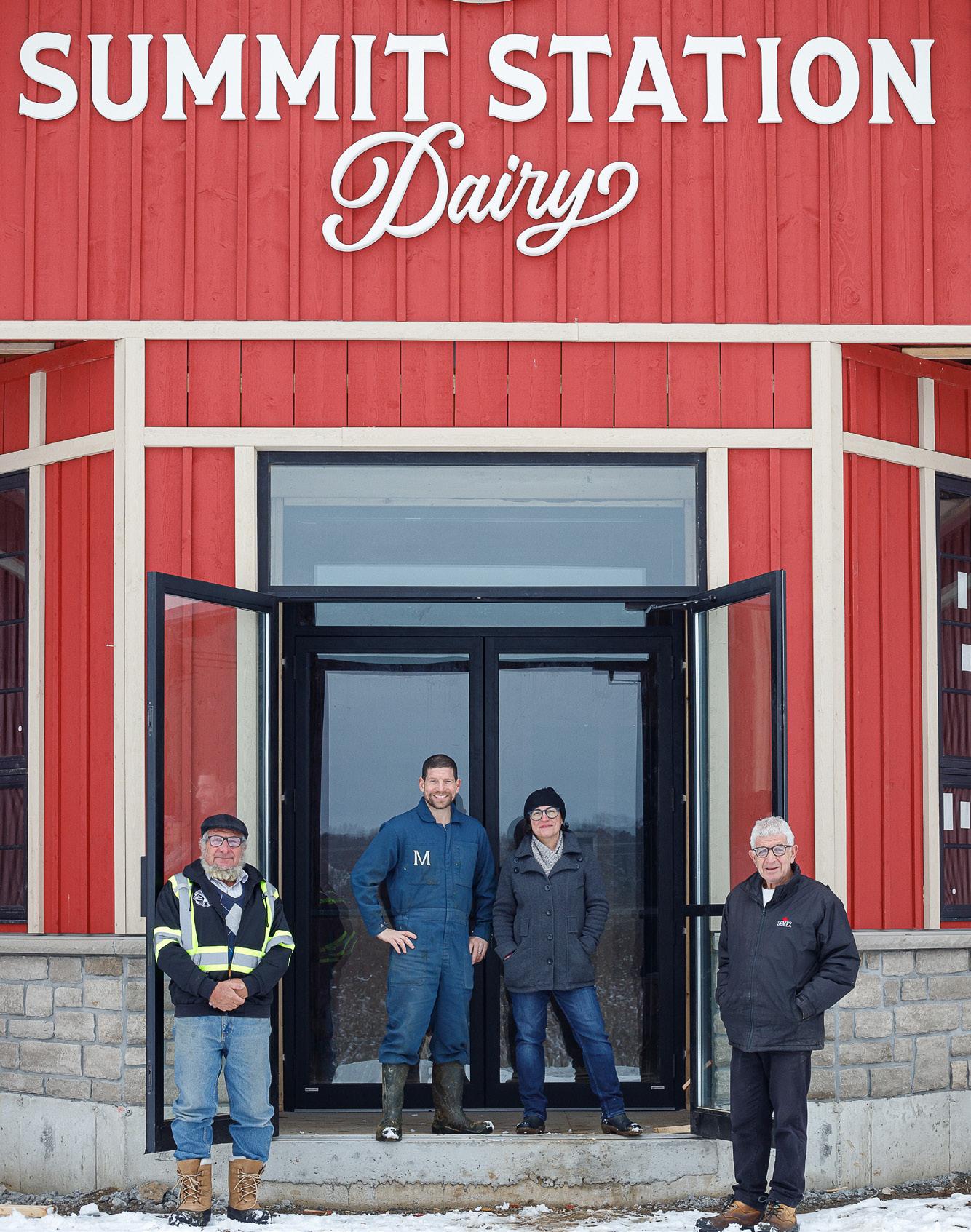
It will be named after the former Summit Station of the Toronto, Hamilton and Buffalo railway.
The dairy building’s architectural features will be based on the original station, which once stood across Highway 52 from the farm.
Milk delivery is scheduled to start in June and the dairy is expected to be open to the public this fall. summitstationdairy.com

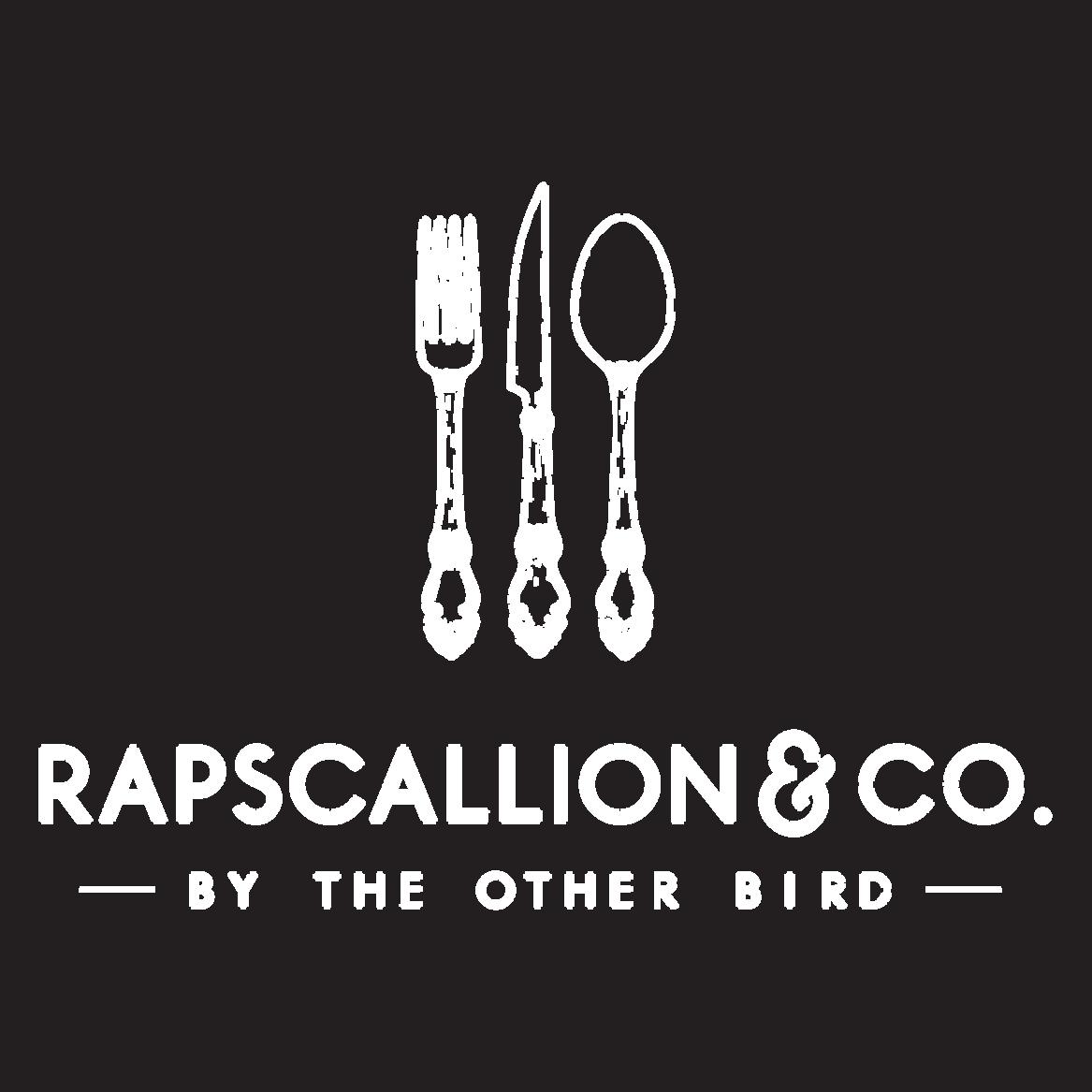








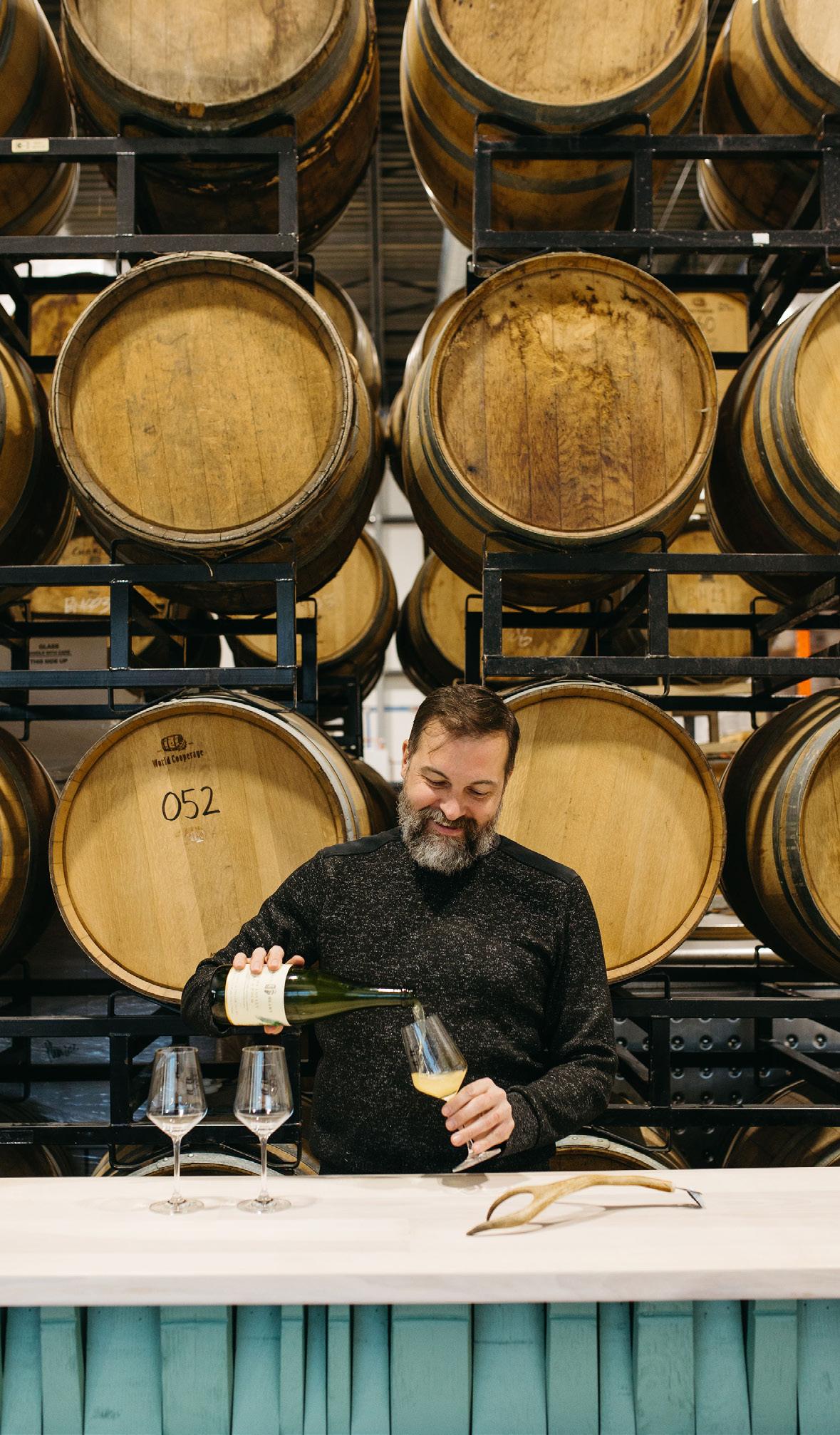
Anew brewery that offers beer drinkers “an expression of love and oak” has opened its doors in Ancaster. Headed by veteran brewer Mark Horsley, Barrel Heart Brewing & Blending produces Belgian-inspired beers made in the saison style (a traditional French beer for seasonal workers). After harvest, Horsley begins aging new beers in oak barrels from nearby wineries in Niagara. Over winter, he awaits while the beer interacts with the microflora in the barrels’ wood; each barrel developing its own flavours over time. In the spring, he tastes his stock and blends various barrels together to create unique flavours. In the summer, Horsley turns to farmers in the Niagara Valley for seasonal fruit, such as cherries, raspberries, plums, and blackcurrants. He then re-ferments the beer on the fresh fruit to complete dryness, with practically no residual sugar. Once bottled and left to mature in his cellar, these beers are then released ready-to-drink. The whole process takes Horsley well over a year to craft a single beer. Having worked as a brewmaster for more than a decade, Horsley is no stranger to making less time-intensive beers, with a list of award-winning IPAs and stouts to his name. When asked what drives his passion for barrel-aged beer, Horsley says: “The process is beautiful chaos. For as much control as I might have over the brewing process, each barrel imprints its own flavours on the beer in unique ways. Blending the mature barrels of beer back together into a cohesive form that complements seasonal fruit, or expresses our base beer in its best form, is infinitely exciting to taste and share.” n
Barrel Heart Brewing & Blending (IG: @ barrelheartbrewing ) is located at Unit 20/53 Bittern St. in Ancaster. To visit the brewery’s online bottle shop, go to barrelheart.com
For more than a century, Hamilton has been known as the Ambitious City –a place for tenacious entrepreneurs to grow big dreams against a backdrop of industrial innovation and an eclectic arts and culture scene. Among the many businesses to have cropped up across the city, no other epitomizes the motivating moniker quite like Collective Arts Brewing.
The bustling Burlington Street East brewery borders the city’s salt-of-the-earth industrial zone and edgy North End art district – the birthplace of Hamilton’s creative renaissance. It specializes in hoppy pale ales with art-forward labels featuring creative talent from around the world. It’s also home to an impressive production facility, retail store, taproom and ultra-express home delivery service to cater to craft beer drinkers. And its biannual call for art has featured more than 2,500 artists on beverage labels, with more than 50 million cans and bottles distributed globally.
Plus, Collective Art’s portfolio of products has expanded beyond beer to include topshelf, award-winning spirits, ciders, canned cocktails, botanical waters, and even cannabis-infused beverages. So, how did a gamble on fusing together art and beer grow into a full-blown craft beverage empire?

“Being rooted in creativity, our thought was if we did it authentically and purposefully, it would allow us to stand out from the crowd – not just locally but anywhere in the world,” says Matt Johnston, co-founder and CEO of Collective Arts. “After that, we could expand to other like-minded categories where the consumer values creativity. That’s the journey we’re on.”
In 2011, Johnston and co-founder Bob Russell hatched their dream project. They wanted to collaborate on something new –a company that not only fostered creativity, but was perpetually changing to always be engaging with its consumers.
Both had ample experience in the alcoholic beverage industry and in building brands that resonated, emotionally, with the people they served. They also knew how challenging it could be for talented artists and musicians to be seen and heard, locally and on the global stage.
“That’s when we had the idea that a brewery could actually be a platform to champion
HOMETOWN BREWERY COLLECTIVE ARTS HAS CREATED ITS VISION FOR THE ‘WORLD’S MOST REFRESHING ART GALLERY’ RIGHT HERE IN HAMILTON.Colle C tive Arts’ Burlington s treet eA st B rewery is home to A produ C tion fAC ility, retA il store, tA proom A nd ultr A -express home delivery servi C e. photos: submitted
emerging artists, and how we could use beer labels to create the world’s most refreshing art gallery,” Johnston explains. “Through quality and creativity, both inside and outside of the can, we could engage people not only in Canada but around the world.”
The problem was, as Johnston puts it, the pair had “little money in their jeans.” They also didn’t have a production space, staff or equipment to make beer. But with that rare blend of determination and grit that makes succeeding the only option, the pair turned to existing breweries for help to produce their starting lineup of craft beers – an arrangement known within the industry as contract brewing. And while beverage recipes were in development, Johnston and Russell made their next pivotal move – they reached out to a vast creative community to inspire the art-fueled labels that have come to characterize Collective Arts.
“About six months prior to pouring our first pint, we did our first global call for art,” Johnston recalls. “That was a scary feeling – going out into the arts world and saying, ‘Hey, we haven’t made any beer yet, but we want you to trust us to take care of that — and we’ll pay you a stipend. Plus, we’ll only have limited use of your work, so we’re really artist friendly.”
Amazingly, Collective Arts’ inaugural call for creative received an overwhelming response from multimedia artists worldwide. More than 800 submissions later and the brewery released its first beers with carefully curated labels showcasing the work of more than 90 visual artists, musicians, filmmakers and photographers. This enabled consumers to visually discover the artists being featured on their beer, while also creating a brand experience like no other on the market.
“For the time, what we put forward was pretty disruptive,” Johnston says. “We really weren’t sure if it was going to be the art or the beer community that was going to embrace us.”
As it turns out, both did. Soon after launching, Collective Arts’ flagship product, Rhyme & Reason, became the top-selling beer in Ontario. Its near-instant success left Johnston and Russell with another problem. If they were going to keep up with demand, they needed a space of their own. That’s when they turned to a 67-year-old defunct brewery in Hamilton formerly operated by Lakeport.
In 2007, Labatt/AB InBev bought Hamilton’s Lakeport Brewing Company with the intention of shutting down the 50,000-squarefoot brewery known for its “buck-a-bottle” beers. In closing its doors, the conglomerate made it next to impossible for another brewery to operate in the facility.
“The building was torched, concrete was poured into the drains, lines were cut, and equipment sold for scrap,” Johnston says. “At the time, we thought there might be some benefit to moving into a space that was once a brewery – but we were wrong.”
Getting the facility up and running to produce beer again would be an incredibly labourious process. Even so, after scanning the region for a space to set up shop, both Johnston and Russell were drawn to the derelict building for a number of reasons.
“For one, Bob and I were born in Hamilton and have a love and affinity for the city. It’s also such a dynamic city that’s both industrious and creative, so it felt like home to us,” Johnston adds. “Plus, craft beer is the antithesis of global, multinational breweries. It just
felt right to be able to resurrect a brewery on a site that a macro-brewery shut down.”
Today, Collective Arts products can be found in parts of the U.S., Europe, and Asia. A second taproom and innovation brewery is located in the hip Trinity-Bellwoods neighbourhood of Toronto. A satellite location slated for New York City’s Brooklyn borough has been a long time coming, however, plans to bring the brewery to life are still in the works. But despite Collective Arts’ wide reach, the revitalized Burlington Street brewery continues to serve as headquarters and home-base for the more than 100 people it employs.
Before the COVID-19 pandemic, the brewery’s annual Liquid Arts Festival invited local and international breweries to pour beer for crowds of people, while live music and art unfolded around them, including massive murals on Collective Arts’ walls. Johnston says the festival’s return, along with other experiences that have helped put Hamilton on the map as a destination for craft beer coupled with a cool arts scene, is definitely in the cards for the near future.
“We have an obnoxious internal goal of being a pride point for the city – a company that people would be proud to say is from Hamilton, and one that brings value, not only through jobs, but through the events we do, and contributing to the quality of life of Hamiltonians,” says Johnston.
So, what words of wisdom does Johnston have for other visionary entrepreneurs who may turn to Hamilton to follow their dreams?
“When you have a big dream, you want to run as fast as you can towards it, but it’s good to be patient and thoughtful. It’s important to have that big white light at the end of the tunnel to run towards, and that you still want to run towards, even when you get knocked down a couple of times,” Johnston says. “And at the end of the day, it’s good to be excited for what’s ahead. That’s what motivates us –the mission in front of us to bring creativity to the every day. Because creativity makes the world a better place. Creativity leads to better decisions, a better life, a better culture. If we can provide some of that inspiration to others, then we’ll take the bumps and bruises along the way.” n











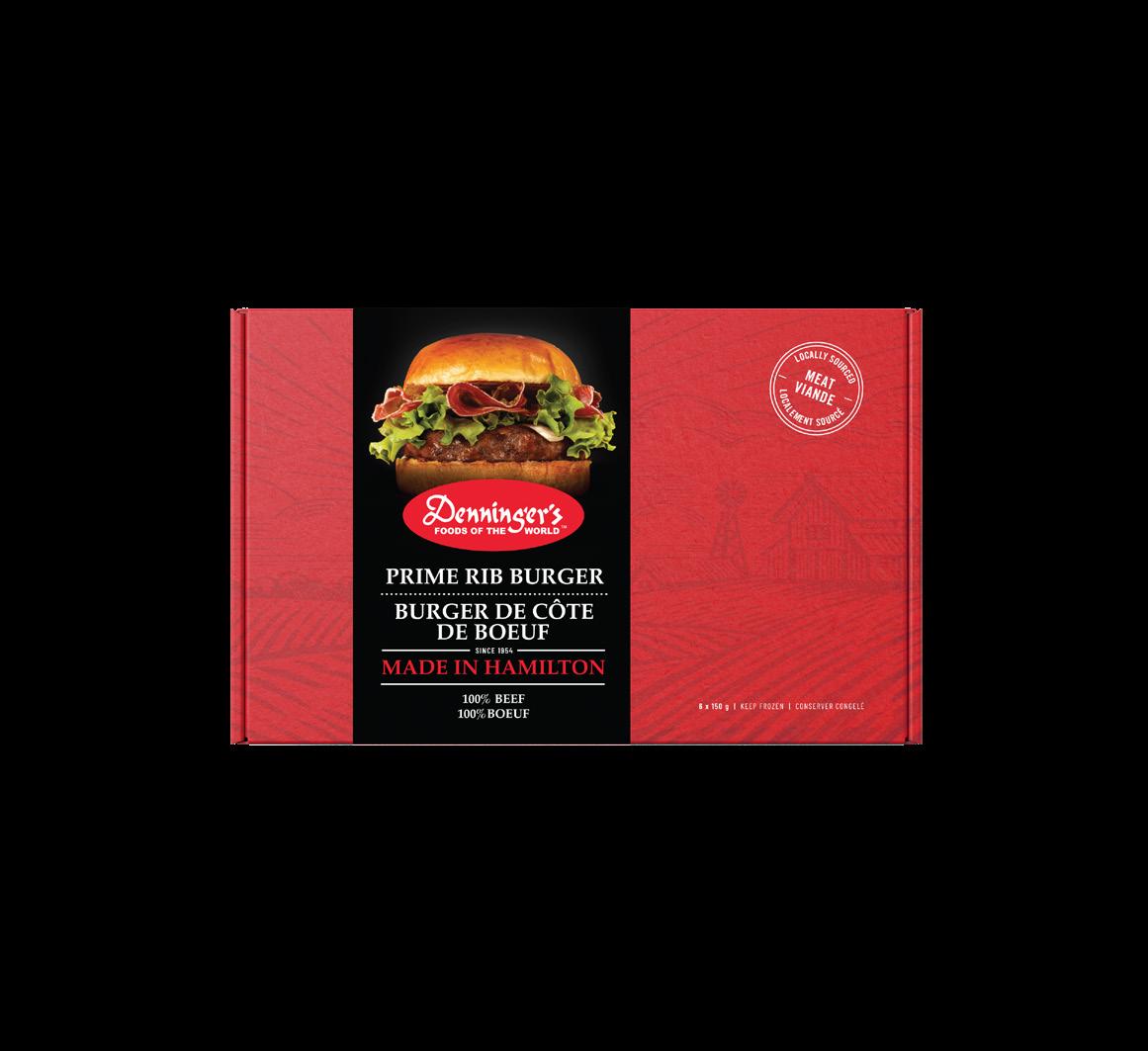



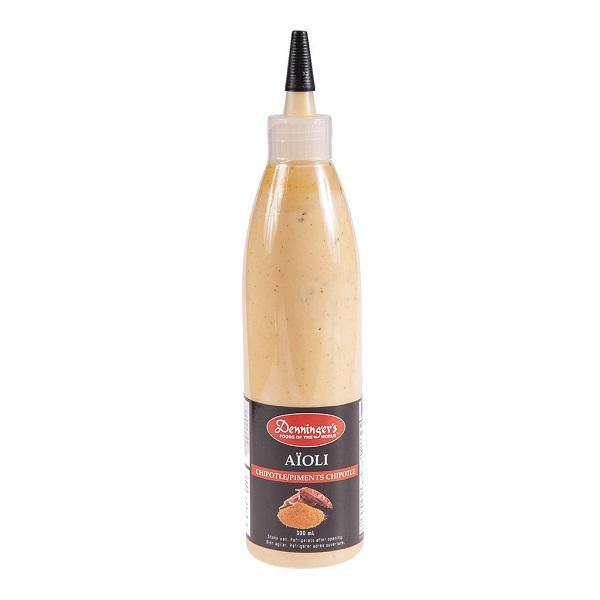

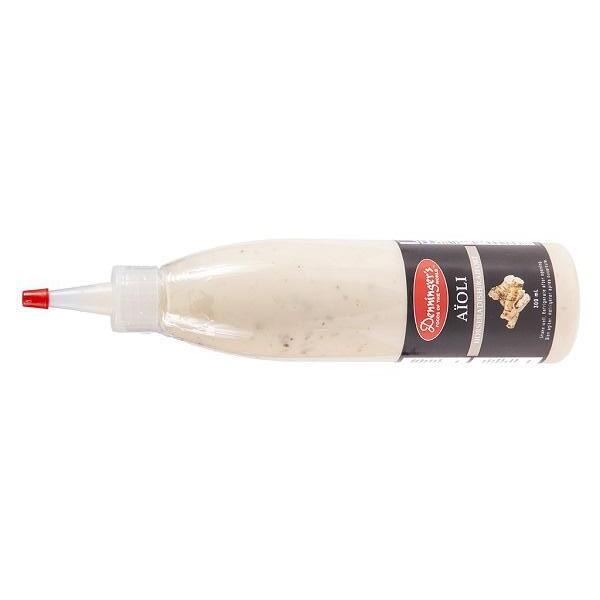



MATTY COWAN’S THE HEATHER GOT A SECOND CHANCE AT SUCCESS THANKS TO AN UNLIKELY SOURCE OF INSPIRATION AND COLLABORATION.
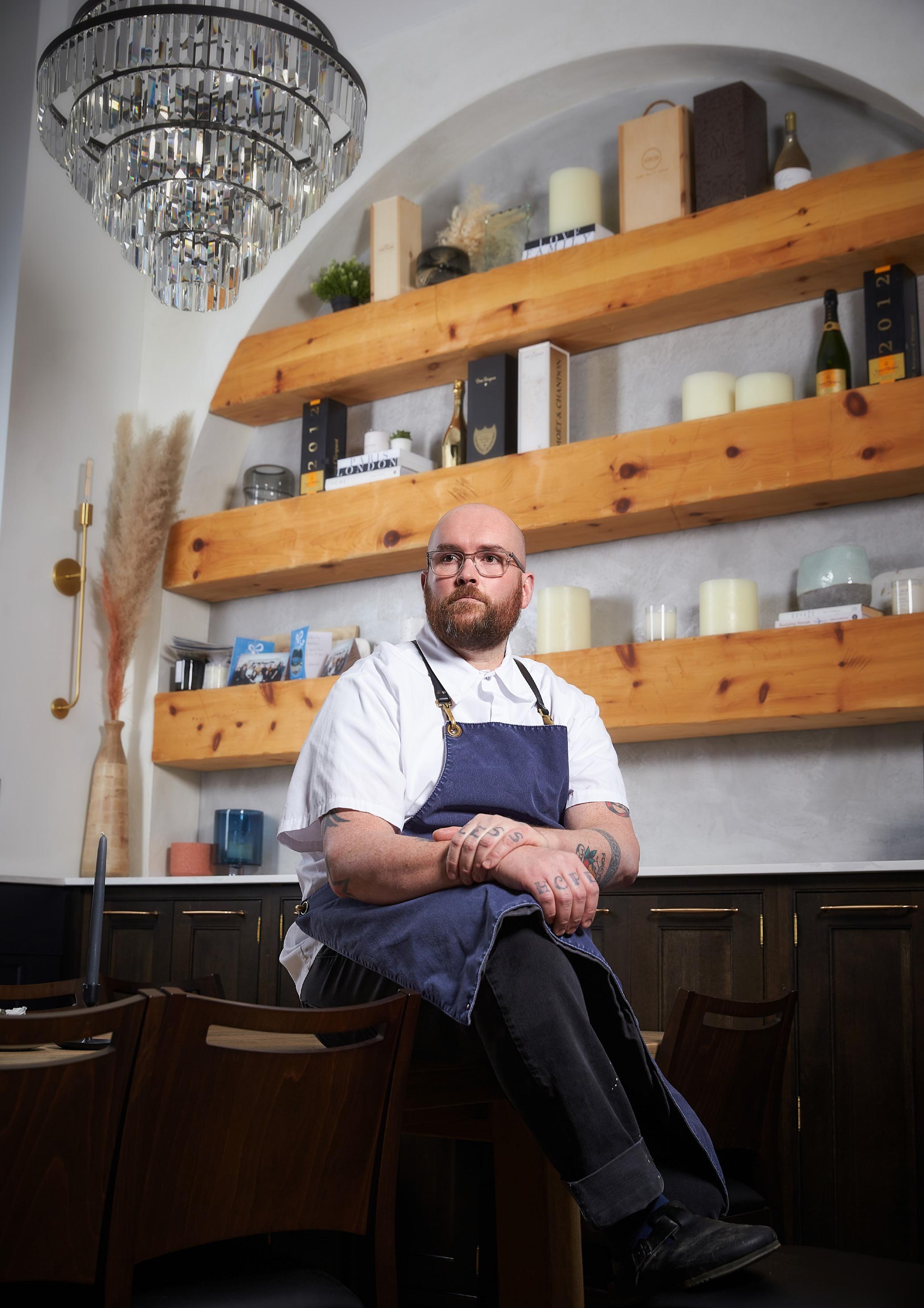 By Vanessa Green. Photos B y Jon eV ans for hcm.
By Vanessa Green. Photos B y Jon eV ans for hcm.
Luckily for Matty Cowan, chef at Hamilton’s newly re-opened The Heather on Locke, he had a guardian angel waiting for him in the wings.
“Without Dao, I wouldn’t be back here (in Hamilton). She believed in me enough to stay patient. I’m grateful to her for forever having faith in me and believing in The Heather and believing that it would work in this space,” says Cowan. “(If not for her), I’d just be stuck doing other people’s food for the rest of my life.”
Dao is Dao Nguyen, founder of Modern Design Studio, an interior design shop specializing in residential and commercial developments that relocated to Locke Street from Ancaster in 2020.
When Nguyen bought the building, formerly the home of NaRoma Pizza, she decided to keep the restaurant and liquor licence. She then redesigned the old kitchen to work as a showroom-slash-multi-functional event space and used the building’s top floor as the design studio’s office.
Even during COVID, Modern Design Stu-
dio’s pop-up events and chef table dinners were a huge success, and Nguyen saw a demand from her clientele for a more permanent dining experience.
She knew Cowan was the only chef she could ask to take on the job.
Nguyen hadn’t met Cowan prior to offering him a spot in her kitchen, but she’d heard about him through mutual friends, and his name kept coming up in conversations about finding a chef for the space.
Though Nguyen has deep experience in both design and hospitality, she didn’t want to be involved in the day-to-day operations of the restaurant side of the business.
She knew she needed someone who could take ownership of the entire operation of the restaurant. She was surprised at what a challenge this was: not many chefs she spoke to were ready to take on all the responsibilities of running their own restaurant.
“If you’re going to ask me anything about the restaurant industry and if you’re going to
look to me for guidance, I can’t help you,” says Nguyen matter-of-factly. “I knew I wanted him because he had (run) a restaurant before. He had done dinner service alone before, and he knows what it’s like.”
Initially, though, Cowan turned her down. “I reached out to him. And he was like, ‘This opportunity is too good to be true. I can’t do this.’ And I said, ‘OK, well, you know where to find me if you change your mind.’”
The reluctance on Cowan’s behalf is understandable. During the pandemic, he was forced to shutter the previous location of The Heather on Barton Street East and eventually declared bankruptcy.
Though the restaurant, which is named after his late mother, had been a success during its run from 2016 to 2021, Cowan found it impossible to pivot a six-seater chef’s table restaurant during the pandemic. He was able to fill up instantly when COVID restrictions lifted, but the repeated lockdowns ate into his already razor-thin margins.

His time on Barton was not smooth sailing either. A mob of local anarchists, angry at what they perceived as the gentrification of Hamilton’s east end, smashed through the restaurant’s front window and left threatening letters that read: “If you build it, we will burn it.”
When it launched in 2016, The Heather was something completely different on Hamilton’s then-burgeoning restaurant scene. Though the restaurant started with tables to seat 12, it eventually evolved into an intimate six-seater chef’s counter dining experience. This is where Cowan worked his magic, prepping, cooking and serving each of the menu’s 12 courses, not to mention crafting cocktails and pouring drinks during dinner service.
Ngyuen wanted to see The Heather come alive again. She was focused and persistent, and, eventually, she won Cowan over. The restaurant reopened its doors in December 2022.
“It keeps feeling like we were destined to come together,” says Cowan. “There’s been a bunch of those little moments where it’s like, ‘OK, this is clear. This is in the stars.’”
Aside from the intimate and unique dining experience The Heather offers, for many, it’s Cowan himself who is the real draw. A gentle giant with a welcoming smile, he’s known for putting his guests at ease and removing all the pretense of fine dining so guests can let their hair down.
“(At The Heather), you feel like you’re at a friend’s house having dinner. I know my personality. I know that I make people relax in their seats, (their) shoulders drop a little bit,” explains Cowan. “(Guests) feel like they can loosen their belts. And that’s what I want. I love the food of fine dining. But I hate all the pomp and circumstance. I want to relax when I eat.”
As well as running his own spot for years, Cowan also has an impressive resumé, with stints at top-tier restaurants across Ontario, including Steak Frites and Portland Variety in Toronto, the Millcroft Inn & Spa in Alton and Devonshire Inn on the Lake in Wellington, now known as The Drake Devonshire.
According to Cowan, the food at The Heather on Locke is modern Canadian. “(But) it’s a hard thing to put a pin in,” he says.
“I’m not going to say it’s inspired by any menu, but it is loosely kind of based on the Koseki or Omakase concepts around food, which is super seasonal, super local. It’s a hodgepodge of different techniques and different styles, from different countries, like French, Italian and Japanese. I feel my food is a little bit more anchored in fine dining comfort.”
The menu at The Heather (which changes seasonally) is wholly a reflection of Cowan’s style of dining. All the ingredients are Canadian-sourced (the next mission is to create an all-Ontario menu). The current 12-course menu – which Cowan likes to keep under wraps to add to the excitement of the experience – features mouth-watering dishes like Nova Scotian diver scallop with fennel purée and green apple relish, and lamb sweetbreads with brioche crumb, green peppercorn aioli and quail egg. Each course is paired with a wine, beer or spirit, some local and some sourced internationally.
Though Ngyuen technically owns The Heather on Locke, Cowan has full operational and creative control of the restaurant. While they work independently in their own businesses, they also take a collaborative approach to building out this one-of-a-kind experience in Hamilton.
One thing that helped solidify this partnership was their shared belief that the restaurant industry is inherently broken. Together, they are doing what they can to turn things around.
“I think the whole industry needs to be flipped on its head right now,” says Cowan. “But nobody’s talking about how to fix it.
We’re all just kind of sticking our heads in the sand and (saying), ‘Somebody else will figure it out.’ It’s the only industry that gets away with total abuse (and) then [is] still held on a pedestal,” says Cowan.
“Kitchens should be happy. They should be fun places to work. I was that chef in my late 20s, then I hit my early 30s, and I had a self-realization, like, ‘Why am I so mad, man? We’re just cooking’. But you often are a product of the schools you come up in. I was strong enough to realize it myself. And I didn’t want to be that way anymore.”
One lesson Cowan learned throughout the years when it comes to his food is that you can’t please everyone. When he first launched The Heather back in 2016, he dabbled in all-day service, with brunch and lunch and menus that catered to every dietary need and restriction.
But he’s pared all of that back now.
When it comes to his menu at The Heather, what you see is what you get. No substitutions. Period.
“The prep takes days. I don’t think people realize how much work goes into it,” says Cowan. “So if I have to stop and make a nondairy version for every course, it’s so much more work. And I’ve always promised myself to stay true to who I am. I find you are more authentic – and the law of attraction grows a little stronger – when you’re just like, this
is what I do, this is what I offer. And that’s it. I can only cook for the people who are open to what I do for sharing. I can’t please everybody.”
And Hamiltonians are A-OK with that. The reopening of The Heather has been a resounding success. Within its first week, The Heather on Locke’s eight-seater chef’s counter was booked solid for three months.
“I can’t believe that word got out there that fast. I just didn’t realize I was missed. I was like, ‘Yeah, Hamilton won’t know I’m gone. It’s fine,’” says Cowan. “I can’t tell you how humbled and grateful I am. It means a ton as a chef. That’s all we want. We want people to enjoy what we do. So the fact that people actually missed me not being around, it means a ton for sure.”
This reopening also means a move for Cowan and his fiancée from Toronto (where he worked for the past few years) back to Hamilton, into a townhouse off Locke.
“There was a sticker shock moving back to Hamilton and seeing how crazy the rent has gone up,” says Cowan. “But it’s also promising as a restaurateur that prices are going up because it means there’s a market out there to sustain the restaurant.”
“I love Hamilton. If I didn’t, I wouldn’t be back,” says Cowan. “What I love about Hamilton is it’s got the city infrastructure, but it’s very much still small-town vibes. You can walk by someone and say hi and they don’t scowl, and they’ll actually say hi back to you. And the tight-knit community. If I need anything, I know I’ve got friends a short distance (away) that will give me a hand. Hamilton’s just got that charm that I enjoy.”
Cowan is excited to be back as a part of Hamilton’s ever-expanding food scene, which continues to thrive despite setbacks resulting from the pandemic.
“It’s exciting to be a part of it,” says Cowan. “That was one of the heartbreaking things with having to close (the original location of The Heather) is that I was one of the first kind of outsiders to be on the scene and opening something different. And then the pandemic happened and ruined all of that. But five years later, we’re still here. So giddy up!” n
I th I nk the whole I ndustry needs to be fl I pped on I ts head r I ght now, b ut nobody’s talk I ng about how to f I x I t. w e’re all just k I nd of st I ck I ng our heads I n the sand and (say I ng), ‘ s omebody else w I ll f I gure I t out.’”
m atty c owan
A WISE MAN ONCE SAID THAT ‘LIFE IS LIKE A BOX OF CHOCOLATES, YOU NEVER KNOW WHAT YOU’RE GONNA GET’ AND IN THAT REGARD, THE HAMILTON-BURLINGTON AREA HAS NO SHORTAGE OF GUMP-WORTHY DECADENCE.
By Heat H er PeterChocolate is a guilty pleasure for so many and the variety of chocolatiers and chocolate options we have in the city would make Willy Wonka – and Forrest Gump – proud. From melt-in-your-mouth truffles and bonbons to luxurious filled chocolate bars and Belgian chocolate drinks, those with a sweet tooth are spoiled for choice in both Hamilton and Burlington. Find some of our favourite chocolatiers on pages 46-47 and let your sweet tooth guide you.



50 King St. W., Dundas beanermunky.com
IG: @beanermunkychoc
In the heart of Dundas, Beanermunky Chocolate specializes in fork-dipped artisan chocolates and confections. Best known for its truffle-style chocolates, Beanermunky opened its first location in 2005 (in the Hamilton Farmers’ Market) and has been going strong in Dundas since 2011. All of the chocolates are made on-site by hand with high-quality ingredients and include flavours like chai latte, raspberry merlot, peanut Skor crunch, cassis noir, key lime pie and many more. In addition to its specialty fork-dipped chocolates, Beanermunky offers confections such as bear paws, caramel pretzels and chocolate popcorn.
123 James St. N., Hamilton chocolatonjames.com
IG: @Chocolatonjames
Chocolat on James was opened in 2015 by Sheryl Cronsberry. Alongside her team, Sheryl built up Chocolat on James to the popular chocolate haven that it is today. In 2022, Mary Nguyen – a professional pastry baker – took over the reins and continues the delicious product lines at Chocolat on James. The large location has many chocolatey options to choose from, but it is best known for truffles, peanut butter cups, dipped marshmallows, fudge, bars, and chocolate-dipped Oreos. Chocolat on James also has a variety of hot drinks, including a decadent hot chocolate lineup.
165 Locke St. S., Hamilton madambonbon.ca
IG: @madam_bonbon
Madam Bonbon is one of the newest chocolatiers on the scene and is creating a buzz with some truly eye-catching and vibrant new creations. Previously working out of a shared kitchen, its burgeoning popularity has allowed it to open a standalone location on Locke Street. At Madam Bonbon, the focus is on creating some unique flavour combinations for shiny, decorated bonbons: hibiscus rosehip, cherry pistachio, Earl Grey & cookie crunch, honey peanut and more. In addition to its main bonbon product line, it has flavoured chocolate bars and salted butter caramels – both with unique flavours as well. Check out Madam Bonbon’s social media to discover seasonal flavours.
3530 Mainway, Burlington christysgourmetgifts.com
IG: @christysgourmet
A Burlington favourite since 2002, Christy’s Gourmet Gifts began with its Christy’s Crunch product – a chocolate, toffee and biscuit creation of which the recipe has been passed down through generations of Christy’s family. (The company continues to be family-run today.) The Christy’s Crunch products, alongside fluffy shortbread, continue to be one of the mainstays of the business, with additions to the offerings such as decorated sugar cookies, Belgian bites, hot chocolate spoons, brittles and other chocolate-dipped treats. Christy’s also offers chocolate-making events with master chocolatier Bernhard.


1050 King St. W., Hamilton
3350 Fairview St., Burlington walkerschocolates.ca
IG: @walkerschocolates


Most in Hamilton know Walker’s Chocolates. It has been serving up sweet treats in the area since the early ‘80s, and has made a name for itself locally, with its first shop opening in Burlington and then opening two more stores in Hamilton in the following years. Though it has a wide variety of moulded chocolate offerings, Walker’s is best-known for its mint meltaways, double-dipped cherries, and sea salt caramels. The company continues to be a family affair, with the second generation now at the helm of the company.


240 Wilson St. E., Ancaster 89 Grand River St. N., Paris chocolatesensations.ca
IG: chocolatesensations_
Beginning as a home-based business in 2003, Chocolate Sensations got its brick and mortar start with an original location in Paris and recently expanded to open a location in the Ancaster Village. Both locations offer a wide variety of high-quality chocolate products, including chocolate-dipped strawberries, truffles, flavoured chocolate bars, and chocolate-dipped treats (Oreos, almonds, sour keys, licorice and more). In the warm weather months, it offers Kawartha Dairy ice cream, and “sensational” ice cream bars topped with all sorts of goodies.
1439 Main St. E., Hamilton thedsrtcompany.com
IG: @thedsrtcompany
Headed by its creator, baker and chocolatier Summer Badawi, The DSRT Company has gained popularity over the last few years on social media and beyond and is garnering a reputation for decadent and spectacular DSRT bars. These thick chocolate bars are stuffed with fillings like smorz (semi-sweet ganache, chocolate chips, marshmallow fluff and graham cracker), life of the party (peanut butter ganache, salted caramel, chopped peanuts and Reese’s thins) and so much more. Check out its social media to see what DSRT is making next.
999 Upper Wentworth St., Hamilton 900 Maple Ave., Burlington purdys.com
IG: @purdyschocolatier
Canadian company Purdy’s has become a mainstay in the chocolate community country-wide, with its bold purple packaging, shops, and high-quality chocolate helping it to stand out among the crowd. Customer favourites include sweet Georgia browns: a mix of roasted pecans, soft caramel and chocolate and Purdy’s hedgehogs – finely ground hazelnut and creamy milk chocolate gianduja in the shape of, you guessed it, a hedgehog. Purdy’s also has a variety of vegan and sugar-free offerings, so there is something for everyone.
423 Elizabeth St. Unit 13, Burlington lolachocobar.com
IG: @lolachocobar
Lola Choco Bar & Sweet House is best known for delicious drinks, but it also creates fabulous pastries and – of course – chocolate products. Chocolate-wise, Lola specializes in handmade French bonbons. Flavours include creative options like oat milk double double, key lime, raspberry pistachio crunch, and creme brulée. If you really want to get the full chocolate experience, try the drinking chocolate – a hot drink made with coconut and 100 per cent dark Ecuadorian chocolate; it’s beyond decadent and so delicious.
430 York Blvd., Hamilton chocolatetales.ca
IG: @chocolatetales
Luckily for Hamiltonians, Chocolate Tales creates treats that almost everyone can enjoy –as a peanut-free and tree nut-free chocolatier. Chocolate-wise, it is best known for assorted filled truffles (think dulce de leche, honey lemon, Moscow mule), origin chocolates, and burst bars (milk chocolate marshmallow, dark chocolate cherry), but Chocolate Tales also offers popular virtual classes and in-person workshops. Sugar-free, vegan, nut-free and more, for those with dietary restrictions, this is a great option locally.
605 Concession St., Hamilton candiwerx.com
IG: @candi_werx
Candi Werx on Concession Street is a dream come true for those with a sweet tooth. Hardto-find retro sweet and confectionery products, British imports and locally made artisan chocolate products line the walls of the store. Many of its chocolate products are made in-store by owner Jules, who has close to two decades’ worth of experience serving up candies and sweets. You can find products like 100 Grand, Whatchamacallits, Abba-Zabba, Charleston Chew and so many more. If you’re looking for a specific sweet or chocolate, look no further as they just may have it.
2 King St. W., Hamilton
75 Centennial Pkwy N., Hamilton laurasecord.ca
Laura Secord has quite the history – this Canadian company has been creating chocolates since 1913. When shopping from Laura Secord, you have options: You can either visit one of the local retail outlets or shop online for your treats from its easy-to-use website. Best known for quality chocolate bars, signature chocolates, mint chocolates and maple chocolates, for those looking for traditional-style sweets, Laura Secord is a top-notch option. It also offers a line of peanut-free chocolates, sweets and ice cream.






DIVERSE FLAVOURS ARE ALIVE AND COOKING IN HAMILTON AND WE’RE PROFILING

SEVEN CHEFS WHO ARE PUTTING THE CITY ON THE FOODIE MAP.
By Elain E Mitropoulos | photos B y M arta h E wson and jon E vans, for hc M L to R: john chee - Fisticu FF s, tyler nicklin - r apscallion & c o, mohamed mukhtar - m ade Fresh by papi photo: marta hewson for hcm hair + makeup: katelyn o’neilWhat makes Hamilton a great culinary city? For one, its food scene is home to a rich, and flavourful, cultural mosaic of cuisines that cater to all tastes. It’s a place that not only offers acclaimed fine dining, but also a variety of international cuisines that impress and comfort at every budget level. Whether it’s a plated, multi-course menu or street food that satisfies the soul, the experience of enjoying new, and unique, flavours is never out of reach. And those with food sensitivities or restrictions are never left hungry for a good meal. But, above all else, what makes this city a dining destination for locals and visitors alike is a rising tide of chefs who call Hamilton home, or who have moved to the city to make their culinary mark. Below are just a number of the many fresh and familiar faces to whom we owe our compliments for making Hamilton a diverse city for great food.




hamiltoncitymagazine.ca


scan the qr code to read the extended interviews with each of our chefs, view more photos and watch a behind-the-scenes video of our cover shoot.

what makes this city a dining destination for locals and visitors alike is a rising tide of chefs who call h amilton home, or who have moved to the city to make their culinary mark.
Middle Eastern & gluten-free Pickup points across Hamilton order.myfalafelpapi.ca
Mohamed Mukhtar, who is widely known by his online alias Falafel Papi, was clocking 100-plus hours a week working a side hustle.
On top of a day job as a corporate strategist for a bank, Mukhtar launched a celiac-friendly meal service. Both Mukhtar and his wife are gluten-free; the latter has celiac disease. Together, they found gluten-free food options lacking in both flavour and diversity.
To fill the gap, Mukhtar started cooking delicious Middle East-inspired and celiac-safe food at home, much to the delight of his friends and family.
“One day, I made some falafels. They were gluten-free, they were vegan, and they were delicious and people were like, ‘You need to share these,’” Mukhtar says.
The response reignited a lifelong passion for cooking stemming from Mukhtar’s childhood eating his mom’s homecooked meals.
“She is the falafel queen, and I’ll argue anyone who says otherwise,” Mukhtar laughs. “And you know her food is good, because growing up in Oakville, which wasn’t diverse at the time, kids would come over and ask what’s to eat. They’d be licking their plates.”
Mukhtar’s love for food carried into his 20s, when he started cooking in Toronto restaurants. After earning a commerce degree, he thought he had put cooking behind him. But, a contract working in Dubai saw him juggling nine-tofive at a bank while moonlighting at a Middle Eastern restaurant in the evening. Something kept drawing him back to the kitchen.
“I wanted to learn everything I could,” Mukhtar says. “And when I left Dubai, I had all the experience as a cook, but it still didn’t feel right. I wanted to do something of substantial value and, at that time, my value prop wasn’t strong enough yet.”

food was fuel – sustenance to run faster and jump further as an athlete.
“I used to do track and field, so I always had to maintain a certain amount of calories a day,” Chenje recounts. “And one day, when I came home from school, I learned my mother had broken her foot. I expected my meals were all ready to go but, to my disappointment, she wasn’t there to make them.”
That’s when Chenje taught himself to cook on the fly. By recreating his mother’s dishes, he developed an understanding of how flavours work together to make meals that could not only power his body, but also feed a future career.
As luck would have it, the high school Chenje attended offered vocational cooking classes. So, in Grade 10, he enrolled in the program, and he’s been cooking ever since.
“By the time I graduated high school, I already had a culinary associate certificate and a solid idea of my end goal,” says Chenje, who would go on to attend the Culinary Institute of New York at Munroe College.

To help hone his skills, Chenje later spent a year cooking in Italy before working in top restaurants in New York and Toronto.
“I always knew what I wanted to do, and I never took a side road,” he adds “I stuck to that road, and I’m still on that road. Cooking pushed and propelled me to go further than I ever imagined, and to be in the position where I am now after 15 years in the industry.”
Today, as the executive chef at Afrolicious, Chenje uses his classical cooking skills to take diners on a “food journey” of Black flavours.
46 James St. N., Hamilton afrolicious.ca
PERUVIANO
Peruvian-Italian
254 Locke St. S., Hamilton peruviano.ca
Rather, the Latin cuisine that spans global cultures is steeped in a history uniquely its own. No one knows that better than Gianluca Lulli – chef-owner of Peruviano.

Lulli’s mother is Peruvian while his father is of Italian descent. And with flavour-packed empanadas and pesto chicken on the menu, Lulli’s cultural background is evident at Peruviano. But a deep dive into Peruvian cooking is so much more than a good meal. As Lulli puts it, it’s a masterclass in gastronomic history, with a side of geography.
“So many things came together in Peru to influence its cuisine. Some, of course, with a darker history. At Peruviano, we want to respect that, while also modernizing our food. So, when you’re eating our dishes, focus on the flavour, the texture, and the story,” he advises. “Don’t be afraid to ask questions.”
The migration of people to Peru from Africa, Japan, and China is one such remarkable story. While some travelled to Peru for the promise of land, others were sent as slaves. Today, the country’s diaspora is reflected in a wide range of dishes.
“Peru has one of the highest populations of Chinese living outside of China, so the wok and soy sauce are integral to our cuisine,” Lulli says. “And the Japanese taught us how to perfect ceviche by making it sashimistyle using lime to lightly cook the fish.”
/continued online: hamiltoncitymagazine.ca
Contemporary Canadian 178 James St. N., Hamilton rapandco.ca
Growing up, she spent the better part of her youth sneaking into adult cooking classes and devouring cookbooks, soaking up every morsel of culinary knowledge and technical skill.
So, it’s fitting that Nicklin, who started working in restaurants at age 14, would go on to rise in the culinary ranks. Today, as the chef de cuisine at Rapscallion, she leads a bustling kitchen known for playful dishes that celebrate nose-to-tail dining, courtesy of executive chef Matt Kershaw of The Other Bird restaurant group.
It’s also no wonder that, late last year, national foodservice and hospitality media honoured Nicklin with a prestigious 30-under-30 award – both for her prowess in the kitchen and for being a role model to others forging careers in the industry.

“Cooking is always all I ever wanted to do – there never was another option,” Nicklin says. “When I first started in kitchens, I was a line cook. Slowly, as I absorbed everything around me, I started to be the one showing new staff what to do. And that’s what I love about my job, taking in young talent and helping them grow.”
From ordering ingredients to staffing the back of the house, Nicklin is responsible for ensuring the day-to-day operations in Rapscallion’s kitchen run smoothly. But fostering a supportive kitchen culture is equally as vital to her.
“For me, it’s especially important for young women and those who are LGBTQ2S+ to find their voice in the kitchen,” she adds. “Everyone who comes to work should feel comfortable being themselves.”
Serving brunch, lunch and dinner, on top of a late-night menu on weekends, Nicklin says Rapscallion is a breeding ground for culinary creativity for all occasions.
/ continued online
hamiltoncity magazine.ca
t yler n icklin, chef de cuisine at r apscallion, was recognized with a prestigious 30 -under- 30 award by national foodservice and hospitality media last year.
photo: marta hewson for hcm
Chinese-Malaysian
301 Barton St. E., Hamilton fisticuffsrestaurant.com
John Chee’s career path took a less dangerous, and far tastier, twist. “Originally, I wanted to blow things up on movie sets,” says Chee, who studied chemistry in university while working in restaurant kitchens. “I sort of fell in to cooking because I got promoted to junior sous chef, and my career grew from there.”
For Chee, the thrill of a busy dinner service is a lot like detonating fireworks. So, rather than concentrate on special effects, the chef-owner of Fisticuffs decided to fuse their background in science with a promising career in culinary art.
“Restaurants were always the kind of environment I really liked,” Chee explains. “Whether it was working in Toronto and New York, or in Michelin-star restaurants in Europe, I just fell in love with the rush of being in the kitchen.”
Over the course of their career, Chee’s cooked a wide range of cuisines – from contemporary fine-dining to casual southerncomfort food, and traditional Basque tapas to Middle-Eastern dishes prepared on an open-fire hearth.
So, when it came time to open Fisticuffs in late 2022, Chee and their partner, Caitlin, turned to “flavours from back home” for inspiration and a restaurant concept.
“We wanted to create a company that was based on our backgrounds – Caitlin being Chinese-Malaysian and my family being from the Balkans. And we wanted it to be our own take on the cuisine –the second generation looking at what their grandparents cooked, and making it for themselves to create new traditions,” Chee says.

HANMA Japanese
103 King St. W., Dundas hanmafoods.square.site
his father, a seasoned restaurateur, gave him advice. “He said, you need to pick something and a diesel mechanic makes a lot of money,” recalls Li, laughing.
But on his first day learning the trade, when fellow students asked about Li’s favourite cars, he quickly realized he had zero passion for the automotive industry. Having spent the bulk of his youth working in his family’s restaurants, he knew he loved to cook. He wanted to follow in his father’s footsteps.
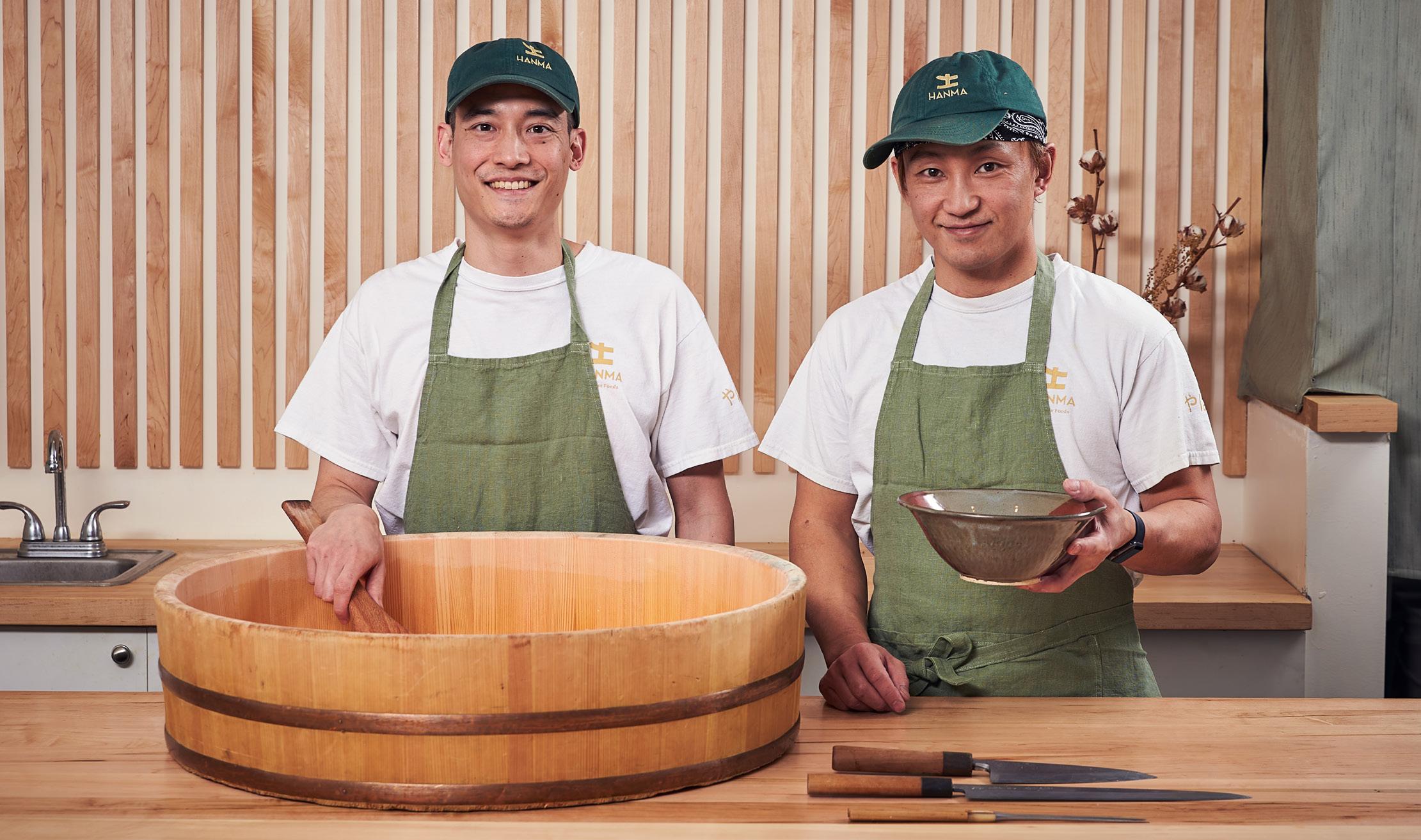
“The next day, I told my dad I wanted to cook seriously. I dropped out of school and enrolled in cooking classes,” Li says. “I think he was happy with my decision and it was what he wanted. But he didn’t want to force it – he knew restaurants could be a hard business.”
Fast-forward to today, and Li knows first-hand how working long hours in hot kitchens can be tough. But the profession also comes with its rewards. Over his career, Li has cooked among some of Canada’s most accomplished chefs, including in his hometown of Vancouver, where he earned his culinary chops at the city’s top seafood restaurant.
And while Li always had his eyes set on working in New York City, it was while cooking French cuisine in Toronto that he had the fortune of meeting his future business partner, Yoshiyuki (Yoshi) Aiba.
/continued online: hamiltoncitymagazine.ca
Scrolling through Instagram, I encountered an account with this comment: “I was so pumped to get three of your sauces in my stocking!”
Admittedly, I’m not a fan of hot sauce, but I seem to be in the minority even in my own family.
Increasingly, I have to rule out many items on a menu because they have been tagged as “spicy” or contain code words signifying spicy ingredients – togarashi, Cholula, nduja, gochujang. Hot honey “stings.” Scotch bonnet does not refer to wardrobe.
Why do so many people like fiery hot food? The explosion of interest in hot sauces is keeping some people busy.
Brodie Dawson is one of those people and the recipient of the aforementioned Christmas stocking love. His embrace of hot sauces ramped up in his 20s.
“When you’re 21 and hilariously broke, hot sauce makes all your very, very bland food taste delicious.”
Experimentation led to the 2013 launch of Dawson’s Hot Sauce. Sold online and distributed so widely as to make wholesale central to the business, Dawson now has a storefront on Barton Street and has been getting international attention.
YouTube’s Hot Ones show features celebrities eating wings dipped into increasingly hot sauces. Dawson’s have been included several times – a marketing coup also bringing attention to the flourishing Hamilton food scene. Heatonist, the trendy Brooklyn shop, sells sauces that appear on Hot Ones, including Dawson’s.
Dawson is not the only local “hot saucier” and many are using or growing local ingredients.

Another Hamiltonian in the Hot Ones Club is Steel City Sauce Co., making sauces since 2017. Says owner Kevin Stuermer, “We love our city and everything in it. It is our mission to spice things up and to educate our friends and neighbours about the benefits of adding a bit of heat to your favourite meals.”
With his It’s That Everythang (sic) Sauce, Canokie Dave (aka David Rochon) is also in the local hot sauce arena. A newcomer to Hamilton with roots in Oklahoma, his profits go to social support programs.
At Delusional Sauce Co., Liz MacKeen and Patrick Kehrer make small-batch sauces. They attribute their brand’s name to their
FOR THOSE WHO LIKE IT ON THE SPICIER SIDE, THERE ARE MANY ENTRANTS TO THE SIZZLING HOT SAUCE GAME IN HAMILTON AND BURLINGTON.
apparent state of mind when deciding that –in a pandemic, with a troubled food industry and Liz eight-and-a-half months pregnant –March 2022 was a great time to launch their business.
Explore Hamilton hot sauces and some common themes appear. With Heat from the Hammer, Jason and Valerie Payne also entered the industry during the pandemic, discovering that every aspect of the enterprise – the work, creativity, connecting with people – was good for mental health. They, too, are philanthropic, donating to local causes. They may also be my entry point into the spice world since their products include sauces for people who don’t think they can tolerate hot sauce. I may start with their snacks.
Says the website: “We are proud Hamiltonians and each product is tied to the geography and history of our great city! We hope you… learn a bit about how amazing Hamilton is!”
Burlington’s Royal Pepper Hot Sauce promises “that from the milder Marquis of Mango to the fiery Tyrant and everything in between, Royal Pepper will take your taste buds to the next level.”
Stoney Creek’s Twisted Tomato Gourmet Ketchups are sidling up to hot sauce with its ghost pepper and chipotle products.
The forerunner of them all is surely Paul Casey who began making hot sauces in 1974 –named for his starting point – Cooksville. He relocated production to Hamilton in 2009. Says the website: we “hold the distinction of being the only Canadian hot sauce in the high Canadian Arctic from Inuvik to Iqaluit.”
The chili peppers used to make hot sauce deliver capsaicin – the chemical compound that triggers a burning sensation – and it is only a sensation. Boiling water or scorching hot food will actually burn mouth tis sue. Capsaicin only activates receptors on the tongue that send a confusing “burn, pain” message to the brain. Except in extreme ly rare cases, there is no harm done to the mouth or digestive system.
The heat levels of chili peppers and hot sauces are ranked as Scoville heat units (SHU). A green pepper score might be zero and the scale goes into the millions for ghost peppers and the grim reaper. Wilbur Scoville created the ranking scale in 1912 by liquefying a pepper’s capsaicinoids and adding a sugar solution in increments until trained taste testers could no longer detect heat. That methodology is considered problematic given that genetically we differ in the number and sensitivity of mouth heat receptors and, over time, tolerance increases. Today, more scientific methods are used to calculate the capsaicinoid content yet they are still reported as Scoville heat units.
None of the above explains why this stinging, burning, fiery condiment is not a tobe-avoided mouth sensation. For many, spicy hot has been part of their diet from childhood, since numerous cuisines embraced the chili peppers that originated in Central and South America. Bird poop is credited for the initial dissemination of seeds, expedited by colonization and trade.
Enhancing bland diets, chili peppers – also thought to be medicinal – were easily grown and quickly became a global ingredient – sort of. Northern climes were late in the uptake, but caught up quickly, with global market values now in the billions. The Gastropod podcast reports that “in 2004, hot sauce and salsa finally conquered ketchup, mustard, and mayonnaise to become the very top two condiments sold in the U.S.”
An incredible range of sweet/ savoury ingredients appears on labels, tempting the palate, including smoke, bourbon, miso, peach, mango, ginger, plus flavours linked to global cultural influences. Is it taste that creates fans? Research has examined the extent to which the popularity of hot sauces may in part be a macho/masochistic thing, linked to thrill-seeking (sought also by women). McGill University’s Office for Science and Society suggests a likely “psychological element at play in spice-lover’s ob-
CANOKIE FOODS canokiefoods.com
IG: @canokiefoods
COOKSVILLE HOT SAUCE cooksvillehotsauce.com
DAWSON’S HOT SAUCE dawsonshotsauce.com
IG: @dawsonshotsauce
DELUSIONAL SAUCE CO. delusionalsauces.com
IG: @delusionalsauces
HEAT FROM THE HAMMER heatfromthehammer.com
IG: @heat_from_the_hammer
ROYAL PEPPER HOT SAUCE royalpepper.ca
IG: @royalpepper.ca
STEEL CITY SAUCE CO. steelcitysauce.com
IG: @saucy905
TWISTED TOMATO twistedtomato.ca
IG: @twistedtomatoketchup
session – studies have shown that many spice enjoyers do feel the burn like spice haters, but find it a pleasurable experience, rather than a painful one. Indeed, it seems that to love spicy food is to take pleasure from the pain.”
By the way, the Scoville methodology hints at how one can counter a hot spicy attack –with sugar, not water. Suffering may have to be endured for a time, but relief can come in the form of sugar or dairy – which is why I always order a mango lassi at Indian restaurants. Something acidic (citrus or tomato) may neutralize the heat, ditto for fats such as tahini or nut butter. Carbohydrate sides such as bread or rice can offer balance.
With respect to hot sauces, the Hammer is now a steel city with a steel gut. Research has found that hot sauce tolerance can increase with repeated exposure. Could there be hope for me? Will I embrace hot sauce by next year’s International Hot Sauce Day on Jan. 22? n
Diane Galambos is a food writer who shares stories and recipes at her blog kitchenbliss.ca Follow her on Instagram @kitchenblissca
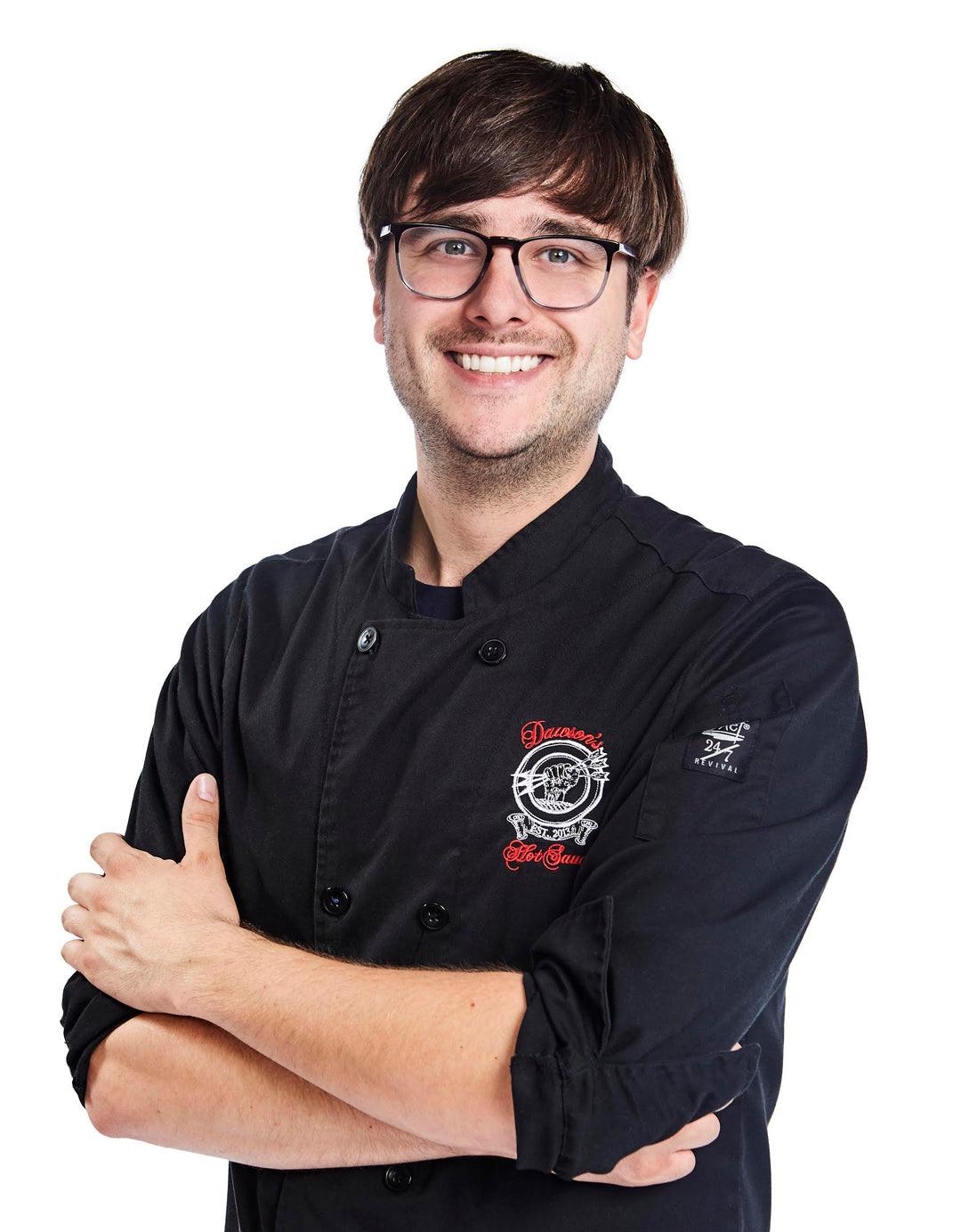

THE HAMILTON AND BURLINGTON AREA BOASTS AN IMPRESSIVE NUMBER OF RESTAURANTS THAT FEATURE ALL MANNER OF CULINARY CULTURES. NO MATTER WHAT YOU’RE CRAVING AND NO MATTER WHAT COUNTRY IT’S FROM, CHANCES ARE YOU CAN FIND IT HERE. WITH THAT IN MIND, WE’VE COMPILED A LIST, BY NO MEANS DEFINITIVE, OF THE MANY LOCAL EATERIES COOKIN’ UP A FEAST OF COUNTRIES AND CULTURES. AND THE BEST PART IS, YOU DON’T HAVE TO PACK!
 By Jody A B erdeen
By Jody A B erdeen
When you drive into Hamilton along the side roads, the odds are good you’ll see a sign that says “Hamilton: A Community of Communities.” Nowhere is this reality more obvious than in the city’s food scene. Between the influx of newcomers from faraway countries and cultures, and the rise of enterprising chef-owners looking to carry on the traditions of their families and ancestors, Hamilton is rapidly establishing itself as a world-class dining destination.
201 James St. N., Hamilton gateofindia.ca
One of the oldest Indian restaurants in Hamilton, Gate of India offers Bangladeshi-style cuisine, which ranges from mainstream favourites, such as butter chicken and beef and lamb curries, to rarer finds, such as achari masalla (chicken, lamb or beef cooked with achar, or spicy pickled mango) and korai goshi, served sizzling hot at your table.
46 James St. N., Hamilton afrolicious.ca
This family-owned restaurant features a spacious dining area for you to enjoy some of the most delicious multi-ethnic African food anywhere. Be sure to try the excellent mbuzi, the most tender and delectable slow-braised goat meat with onions, peppers, tomato, and cilantro served with ugali, chapati, or white rice.
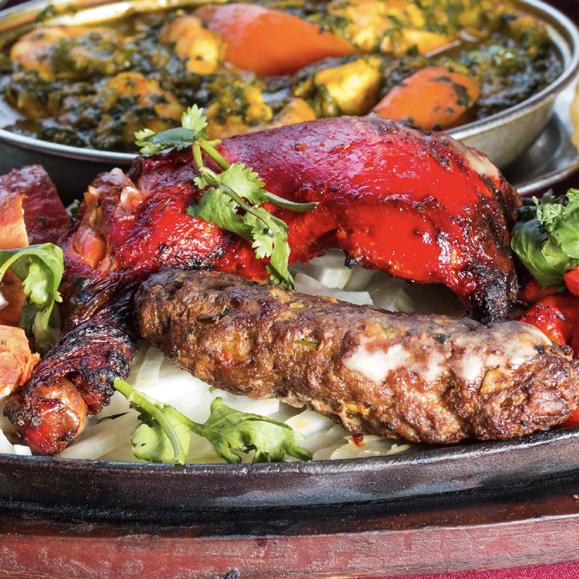

MESA
255 James St. N., Hamilton IG: @mesahamont
Known for its excellent selection of regional Mexican cuisine and generous portion sizes, this James Street North institution has been serving up some of the best barbacoa, chimichangas, and margaritas in the city. To start, try the grilled panela, a Oaxacan cheese and pulled chicken dip served with nachos.

2070 Rymal Rd. E., Hamilton daawatrestaurant.ca
Operated by the same folks who run Desi Grocers, Daawaat features a wide variety of spicy, flavourful Indian, tandoori, and Hakka Chinese meals and snacks, including the hard-to-find idli, a rice cake native to southern India and often served with paneer cheese, chillis, and sambar, a curry lentil stew. Several vegetarian and vegan offerings are also available on the menu.

420 Pearl St., Burlington rayhooneatery.com
Derived from the Persian word for basil, Rayhoon is a hidden treasure tucked away in the heart of downtown Burlington’s cozy Village Square. Sit in the large outdoor seating area in the summer or the welcoming interior dining space in the colder months and enjoy one of the many kabob dishes on offer, including the barg kebob, a Persian-style steak of thinly cut beef tenderloin.
3135 Harvester Rd., Burlington sotiris-restaurant.com

Sotiris Restaurant is an institution in these parts. Established in 1993, the family-owned and operated venue offers some of the most delicious Greek staples, such as chicken and pork souvlaki, served to you in an elegant setting certainly among the most beautiful restaurants in the Golden Horseshoe (and a wonderful place to bring a date!) /continued on page 58

242 King St. W., Hamilton tomahhamilton.ca
Chef, cheesemaker, refugee, and entrepreneur Mohamed Tomeh is one of Hamilton’s great success stories, and his recently opened location on King Street West near Hess is a prime location where you can find authentic Syrian dishes and a wide selection of cheeses. Though it’s safe to say that everything on the menu is delicious, you’ll want to try the Syrian shawarma sandwich, labneh, turkmani cheese sandwich with falafel, and of course, the amazing cheese plate.
1010 King St. W., Hamilton nannaaeatery.com
Westdale’s Nannaa bills itself as “Hamiton’s first fast-casual Persian eatery,” with a mission to accurately represent the food and the hospitality of Persian culture. Here, you can enjoy the amazing chicken tachin (saffron-crusted rice over chicken topped with barberries and almonds, with a yogurt shallot sauce on the side), the koobideh kebab, and freshly baked barbari Persian flatbread. (And don’t forget the signature Nannaa fries!)
MYTHOS GREEK CUISINE
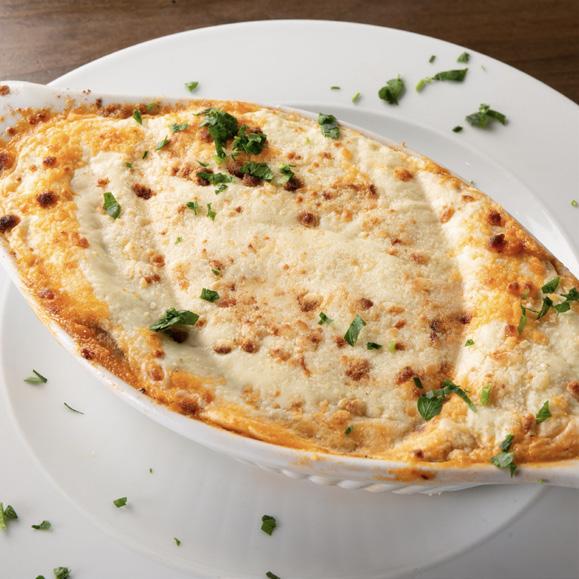

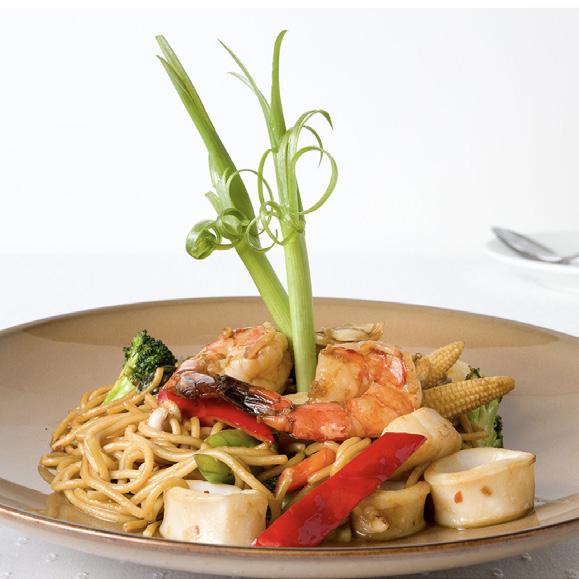
3500 Fairview St., Burlington
mythoscuisine.com
Mythos Greek Cuisine has become a wonderful addition to the culinary experience in Burlington, elevating the standard staple items but also offering a standing four-course prix fixe Taste of Mythos lunch or dinner, featuring two of the most unique meals you can get at a GTA-area restaurants: augolemono, a soup made of broth, egg yolk, and lemon; and lamb giouvetsi, a traditional tomato and lamb stew served with orzo.
261 Queenston Rd., Hamilton flavourslatincuisine.ca

Flavours Latin Cuisine is one of the many stories of pandemic resilience in the Hamilton food scene, having initially opened in March 2020 but forced to close until July. Since then, it has staked a claim as a go-to place for delicious gluten-free dishes, such as fried arepas, plantain sandwiches, and other traditional Latin dishes. During the summer months, the openair patio offers live Latin music for you to dance the night away after your amazing meal.
BANGKOK SPOON DELUXE
57 King St. W., Dundas bangkokspoon.com
Dundas’ own Bangkok Spoon Deluxe has been a well-established favourite for both Valley Town locals and greater Hamilton visitors alike, serving some of the most knock-your-socks-off tom kha kai soup you can find anywhere. While the standard pad Thai is tasty, you’ll want to try basil duck (roasted in garlic, chili, onion, pepper, and basil leaves) and the pad khi mao (crazy drunken noodle), a riff on the famous Bangkok spicy seafood noodles.
CULANTRO PERUVIAN COOKERY

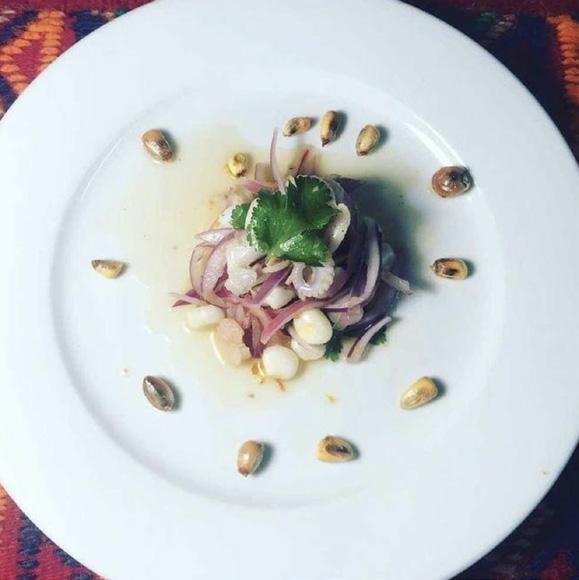
537 Main St. E., Hamilton
IG: @CulantroCookery
With a reputation for a tremendously positive staff and delicious entrees, the chef-owned Culantro Peruvian cookery aims to please and hits the mark with several popular entrees, including the lamb shank, ceviche, and flank steak. The space is cozy and personable, so be sure to reserve a table ahead of time if you’re dining with a group.
66 Mall Rd, Hamilton littlesaigonhamilton.com
Little Saigon is one of this writer’s favourite places to bring a date on the Hamilton Mountain, especially after a busy day of shopping at nearby Lime Ridge Mall. A popular lunch and dinner spot for local residents, Little Saigon not only offers Vietnamese staples – all of the pho offerings are delicious – but also some very well-made Thai and Japanese dishes. Definitely have the cheese wontons as an appetizer –they’re the best in town.
218 King St. E., Hamilton IG: @PanamaCafeCa
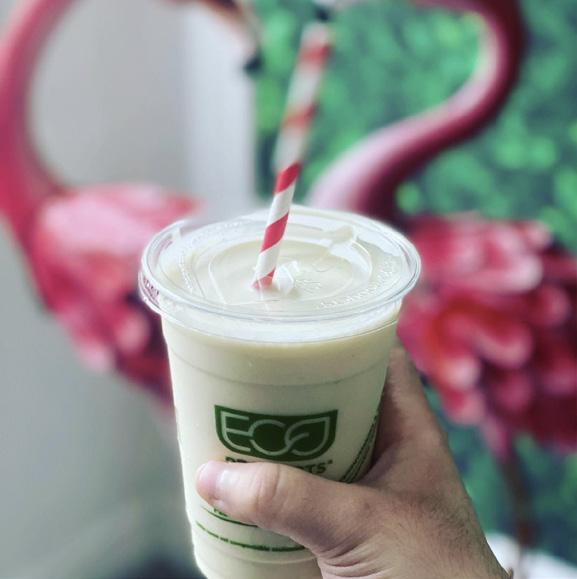
Panama Café is a recent arrival on King Street East, opening in 2022 as a casual, tropical-themed spot to drop in and hang out with a coffee, fruit smoothie, or a tasty snack. Chicken and beef empanadas, a selection of tropical smoothies, such as the signature pina colada, and flan prepared in house are some of the highlights.
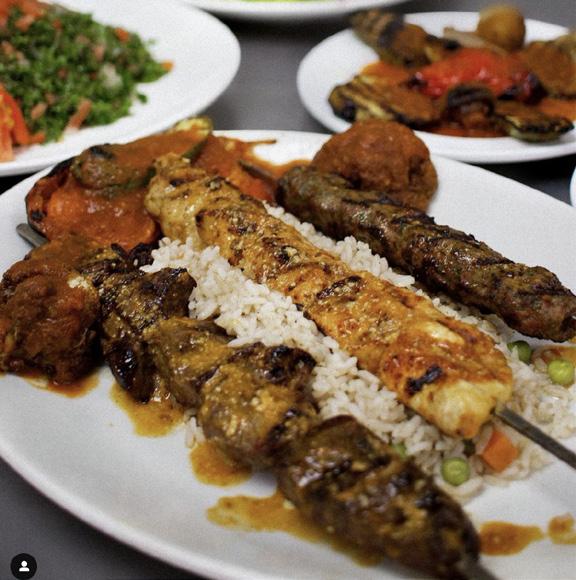
207 James St. S., Hamilton wassethiopianrestaurant.com
If you’re craving some delectable lamb wat and injera flatbread, this is the place to go. Wass not only serves these traditional Ethiopian staples and more, but honours one of Ethiopia’s greatest contributions to the world: coffee. When you dine in, you can request a coffee ceremony. Over the course of 25 minutes, you – and every other nearby diner, since the fragrance fills the air – will experience the full cycle of the coffee bean roasting, grinding, and brewing process, as only true masters of the original preparation can provide.
Various locations, see website for details lalunarestaurants.ca


With locations across the city, La Luna has been a go-to for many Hamiltonians celebrating special events such as birthdays and anniversaries, and, of course, a night out for tasty traditional and elevated Lebanese food. The fattoush salad remains the best in Hamilton, and you’ll be hard-pressed to find a better mazza spread anywhere in the city. One delightful item that often gets overlooked is the mushrooms, freshly-cut and prepared with garlic, lemon juice, sumac, and other spices.
301 Barton St. E., Hamilton fisticuffsrestaurant.com
A recent favourite of local Instagram influencer Emma Lindeman ( @lovelylittlelocal), Fisticuffs bills itself as “Grandma’s kitchen meets night market,” showcasing traditional and innovative Malaysian food that draws inspiration from co-owner Caitlin Chee’s grandmother. The hokkien mee is a standout: noodles, fried soft shell crab, gai lan (Chinese broccoli with oyster sauce), and cabbage. Lindeman loves the beer selection and overall atmosphere and recommends reserving ahead for your group. “I enjoyed the spicy flavours and tea pot cocktails,” she says. “The prawn balls and shrimp chips were highlights.”

1561
gaolaozhuang.ca
In Ainslie West, just behind the Boston Pizza on Main Street West, you’ll find what many regard as the best, most authentic Chinese restaurant in Hamiton. Mr. Gao serves up a wide selection of mainland Sichuan, Cantonese, and regional dishes that are not adjusted to a Western palate, meaning you’re getting the real deal. Start with the mapo doufu and minced pork, a spicy Sichuan preparation of tofu and chili (best ordered as a rice bowl) and proceed to any one of the clay pot stews. The crab and roe seafood rice is worth every bite, and if you’re looking to expand your timid palate beyond the standard dishes, the stirfried pork intestine and green chili is spectacular.
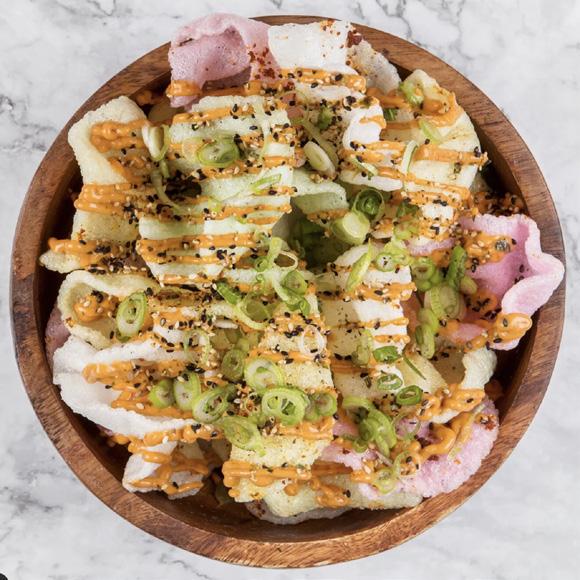
THE 2023 2024 SEASON A CELEBRATION OF THE NEXT 50 YEARS
THEATREAQUARIUS.ORG
If you were a regular at one of Hamilton’s indie music clubs over the past decade or so, you likely stumbled across Cormac Figgis near the front of the stage doing what he does best: shooting the band in question on his digital camera. The Dublin-based photographer called Hamilton home from 2013 to 2019 and as he had done in his native Ireland and throughout the U.K. for a number of years leading up to that, he documented the city’s live music scene in all its sweaty, punk-infused glory. The result is a fascinating photo book entitled Shot From All Sides and Hamilton is featured extensively throughout its 230 pages. From Supercrawl and the Harvest Picnic to This Ain’t Hollywood, Casbah and Absinthe, Figgis’ work is a fascinating snapshot of a Hamilton music scene that is far different in 2023.
Shot From All Sides is Figgis’s first book of live music
photography and is packed with more than 180 grainy and gritty images that capture the musical essence of a literal who’s who of punk and pop including Mickey DeSadist of Hamilton’s The Forgotten Rebels, the New York Dolls, The Stooges, Sex Pistols, Killing Joke, Nick Cave, PiL, Shane Macgowan, Sinead O’Connor, Primal Scream, Al Green, The Specials, Beastie Boys, and countless others. And in true punk fashion, Figgis is publishing the book himself, COVID be damned.
“I was in the process of looking for a publisher when COVID kicked in and killed it,” laments Figgis.
“This year I realized that I could spend another year looking for a publisher, or I could just do it myself. The punk ethos of DIY struck a chord with me back in my teens, so it made sense that this was the only route I should take.” advancerecords.com n

HAMILTON ARTIST CHRIS MYHR’S WORK EXPLORES OUR UNEASY RELATIONSHIP WITH WATER AND HIS MID-CAREER RETROSPECTIVE AT THE MCMASTER MUSEUM OF ART CELEBRATES HIS ONGOING FASCINATION WITH WATER’S CONTRADICTORY NATURE.
By Stephanie VeghChris Myhr thrives on contradictions: he is an artist whose methods look a lot like science, a digital photographer fascinated by the raw, earthly substances found beneath his feet. His sleek, precise images are shaped by the natural inclinations of land and water – especially water, which will always flow by its own will.
Salients, Myhr’s mid-career retrospective on view this winter at the McMaster Museum of Art, collects the clay pipes of seafarers and grotesque lumps of industrial waste washing up from the Great Lakes as evidence of our uneasy relationship with water. An experienced diver who recalls being hypnotized by Halifax’s harbour during grad school at the

Nova Scotia College of Art and Design, Myhr has a life-long fascination for water. This attraction took a dark turn with the 2011 Tohoku earthquake and tsunami – as the spouse of a Japanese person who once lived in that country, watching media coverage of “this dark column of water” carrying buildings and lives away hit horrifically close to home.
The tsunami was a revelation of water’s contradictory nature. Life cannot exist without it, yet water is also capable of unpredictable devastation. That tension is visible in Myhr’s Vessels: Undertone series, featuring glass vessels pulled from the Atlantic seafloor by Halifax diver Bob Chaulk. Startling blue chemical reactions and etched lines show the
passage of deep time sunk in the sediment, while the once-exposed surfaces crawl with lively spores and shells.
While water can consume whole ships and reduce metal to dust, glass and ceramic are uncannily immune to decay. Salients includes many images of clay pipes gathered from a rusty bucket in Chaulk’s storeroom, each framed with the individual dignity of a portrait. As plentiful on the ocean floor as cigarette butts in a city gutter, these pipes are intimate remains of people long gone –a piece of smoke and breath that tumbled below the waves hundreds of years ago, only to be brought back up again.
Myhr also counts scientists among his collaborators, including Dr. Jane Kirk and Amber Gleason from the Canada Centre for Inland Waters in Burlington. Ab-solutes captures their test samples from the Athabasca River, a waterway that flows through protected parks and oilsands alike before emptying into the Arctic Ocean. Dark petroleum sediments are framed by a downward view into a sample pack that also recalls the contours of the camera’s lens.
This work lends visibility to the sometimes-obscure work of environmental scientists, with whom he continues to collaborate on research into mercury contamination in
the Canadian North. As the son of a geologist, Myhr has long learned to reject the opposition of science and art that was so prevalent in his art school days. Both artists and scientists, he has observed, share a common interest in discovering new perspectives on our world. “I’ve realized that they’re really creative people doing very important work.”
Born in Calgary and widely travelled since, Myhr has proudly made his home in Hamilton’s North End since joining the faculty at McMaster University in 2014. His attraction to this place is closely tied to its waterways, which he often explores by foot, bike and kayak. He first noticed a thick green sludge floating on the water during a paddle some eight or nine years ago. He shared his snapshots with colleagues at McMaster, one of whom pointed him to reports of the bluegreen algae bloom afflicting the harbour.
As with much of Myhr’s work, this firsthand encounter was a starting point for deeper research into cause and effect. With
advice from colleagues at McMaster, Myhr evaporated droplets of the contaminated water onto small, thin sheets of glass. These slides, precariously stacked on a digital film scanner, resulted in his Suspensions series –large ghostly photographs of bacteria drawn from our local lake. These images reveal suspended fragments of microbial life in fluid traces that come close to breaching their circular frames, highlighting the uncontrollable quality of his subject.
Myhr has long observed an uneven patchwork of stewardship and abuse surrounding the Great Lakes. While communities like Toledo have fought to enshrine the rights of water in law, Lake Erie is also home to heavy
industry, fracking and dumping. A walk with a friend along the western shoreline of Point Pelee introduced Myhr to dark, rubbery chunks of hydrocarbon sediment washing up from Lake Erie’s various industries. Samples of this deathly black substance are displayed in the exhibition and enlarged in photographs that nearly obscure each individual rock against its own darkness. More recently, after Salients opened, Myhr found similar fragments on the pier near the Skyway Bridge, washed up from Lake Ontario by a recent storm.
His love of Hamilton’s waterways remains deeply troubled by the reality of a municipal bureaucracy that has allowed sewage to be dumped into the lake, even with full knowledge of the consequences. “Someone had to sign off on that – someone that does not have a direct connection with the city, the land, the water, the people.” He recalls the many people who flocked to the waterfront during the darkest days of the pandemic to boost their physical and mental well-being – people who, in turn, found their own emotional connection to the water and have learned to care for its survival.
Myhr’s singular lens insists that we look closely to our water and understand how its health and ours are intertwined. Without that connection, disaster soon follows. n


THE TRUE NORTH GALLERY IN WATERDOWN IS A HIDDEN GEM THAT BOASTS WORKS OF ART FROM SOME OF MUSIC’S MOST ICONIC NAMES. FOR OWNERS GEOFF AND MABRUKA KULAWICK , IT’S A TRULY ONE-OF-A-KIND-LABOUR OF LOVE THAT CELEBRATES THE COMMON INTERSECTION OF MUSICAL GENIUS WITH VISUAL EXPRESSION. By
Kerry Doole
HAMILTON CITY Magazine readers
driving along the 403 may well have been intrigued by the marker indicating the Waterdown exit for the True North Gallery. What is this place? Is it worth a short detour? The answer to that second query is a resounding yes, especially if you are a lover of music and visual art.
The gallery’s full title is True North Gallery/ The Music Gallery of Fine Art, and co-owners Geoff and Mabruka Kulawick are adamant in their belief that this is the world’s only art gallery specifically devoted to the visual art created by notable, and in many cases, iconic musicians.
Geoff Kulawick heads Linus Entertainment, one of Canada’s most important independent music companies and home to the famed roots music labels True North, Stony Plain, and Borealis, and his wife Mabruka is curator of the True North Gallery.
The gallery is installed in Griffin House, a large building in downtown Waterdown that serves as the Linus HQ and warehouse. The Kulawicks did not have to look very far to source material for their new gallery. as an extraordinary proportion of musical artists affiliated with Linus-owned record labels are also talented visual artists who are now well-represented in the True North Gallery.
That list includes Murray McLauchlan, Buffy Sainte-Marie, jazz star Jane Bunnett, Ashley MacIsaac, Barney Bentall, and Marc Jordan. It was actually east coast bad boy fiddle virtuoso MacIsaac that sparked the idea of the gallery in Mabruka Kulawick’s imagination when he sent the Kulawicks one of his original art works as a gift after being signed to the label.
As Mabruka explained in an interview with FYIMusicNews, “that made me realize that a lot of musicians are so talented for things other than their music. I thought, ‘why not create a space that also represented them
as visual artists?’”
Her husband’s research failed to find any other art gallery dedicated to visual art by musicians, so the couple forged ahead with the idea. The Kulawicks contributed pieces from their private collection and, Geoff tells HCM, “we started reaching out to artists, asking to see if we could get their work on consignment. Most of our pieces are on consignment.”
Finding a gallery locale was easy, as there was surplus space available in Griffin House. Geoff recalls that “we found a City of Hamilton loan program for interior renovations and took advantage of that to build the gallery.” The result is a gallery space comprising four rooms, and an expertly curated collection featuring both music superstars and relatively unknown talents.
The True North Gallery turns seven this year. Along with a good number of the exhibiting musician/artists, this scribe was lucky enough to attend its official opening event in March 2016. On hand to discuss the intersection of their music and art were national treasures Sainte-Marie and McLauchlan. In the years following, singer-songwriter Marc Jordan and Louie Perez of Los Lobos are among those to have hosted events in the gallery.
Mabruka and daughter Karina are both accomplished visual artists, and their vibrant work adorns their own studio space just above the gallery. They both gave HCM a recent guided tour of the True North Gallery, and their enthusiasm for the work displayed was palpable.

The gallery’s mandate is to only exhibit the work of musicians who create visual art, or artists who are also active musically. The one exception made has been Andy Warhol, given a pass by virtue of his crucial role in the career of the Velvet Underground and as the inspiration for such musician/artists as Patti Smith. It is no coincidence then that a Warhol work is placed alongside two compelling Smith pieces.
Beatles John, Paul and Ringo are featured with small pieces here, while other legendary musicians represented have included David Bowie, Miles Davis, Joni Mitchell, Leonard Cohen, Graham Nash, Tony Bennett, Janis Joplin, Jimi Hendrix, Phil Collins, Jerry Garcia, Bob Dylan, Eric Clapton, Ron Wood, and Grace Slick.
Currently taking pride of place at True
North is an original self-portrait by David Bowie, created as part of his 1995 album release, Outside. Utilizing pencil and charcoal, the evocative piece is by far the gallery’s most expensive offering, at $100,000. “If one of your readers is so inclined, I’d like to sell that one,” says Geoff. Karina adds that “when people find out we have it, they’ll come just to see it.”
The True North gallery name may suggest a dominant theme of Canadiana, and there are certainly some works hanging that show the influence of the Group of Seven greats and this country’s landscapes. McLauchlan acknowledges the inspiration of Lawren Harris, for instance, and the work of Toronto musician and multi-media artist Kurt Swinghammer also references the landscape and symbols of the Great White North.
Swinghammer is called the Gallery’s most popular artist by the Kulawicks. His Red Canoe series has always sold quickly here, and Swinghammer and True North also collaborated on his Medicine Hat series depicting the late Gord Downie. This was a fundraising project for the Downie-Wenjack Foundation in which all artist and gallery proceeds went to that charity, which aims to build cultural understanding and create a path toward reconciliation between Indigenous and non-Indigenous peoples.
“An immense pleasure to read ... The love of invertebrates and the complexity of human behaviour are beautifully married in this imaginative thriller ... The murders are clever and gruesome ... I thoroughly enjoyed it"

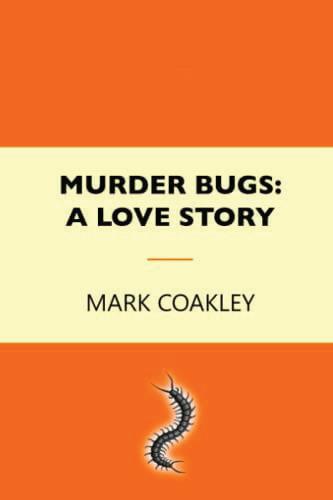
Swinghammer tells HCM that he is thrilled to be affiliated with the True North Gallery. “Personally it’s very meaningful to be included alongside so many significant musicians that I grew up listening to and worshipping. I also love that friends from the local scene, such as the incredibly talented Martin Tielli from the Rheostatics are part of the roster,” he says.
“True North has a fantastic brand identity. Most famous musicians keep their visual art relatively private, so the collection can be a surprising discovery. I dig that Geoff and Mabruka have curated a diverse and eclectic representation that includes three-quarters of the Beatles and half of Half Japanese (U.S. underground punk musician Jad Fair).”
The gallery closed during much of the COVID period, but the Kulawicks report that online sales have been strong. Analyzing the buyers of exhibited work, Mabruka says “it is mostly women buying for their husbands.”
Geoff adds, “there are two kinds of buyers, those who buy for the aesthetics of the piece and those who want to feel a connection with the artist. I’d say it is a relatively equal amount in each category.”

Highway signs aside, the gallery has not done much advertising or marketing, so its existence has been something of a well-kept secret in the Hamilton region. Word has gradually been getting out to the point that musicians/artists are now contacting True North offering their work.
Appointments to tour the True North Gallery are strongly recommended as the gallery is not always staffed during regular business hours and as such may not be able to accommodate walk-in visits without pre-booking.
According to Geoff, the gallery “is more a labour of love than a venture where we can retire from the proceeds. Owning the building means rent is not a factor, and that’s a big advantage.”
To Mabruka : “this is more for the love of it, the sharing of beautiful work these artists have all done. We want people to know there are beautiful pieces here, like the David Bowie, Patti Smith, and Andy Warhol. Come and see them while they are still here. Who knows if there’ll ever be another Bowie work here in Hamilton. Once it’s gone, you’ll be sad you missed out.” n
For more information, visit truenorth.gallery
The True North Gallery vividly demonstrates that many famed musicians also have real skill as visual artists. To get a fix on why musicians paint, HCM interviewed two Toronto musicians featured in the gallery, Kurt Swinghammer and Kevin Hearn, Barenaked Ladies keyboardist, music director for Lou Reed, and a solo recording artist.
To Swinghammer, the two activities (music and art) “can come from the same impulse and share many attributes. In the simplest sense, music is social and visual art is solitary. For me, the two are complementary and make me feel balanced,” he says.
“Perhaps some ‘successful’ musicians need to make art that a producer or industry exec can’t futz with. Maybe their visual art is an outlet for a more pure, direct expression that is uncontaminated by showbiz expectations.”
Swinghammer says that when he did the set design of Joni Mitchell’s MuchMusic special and asked her to sign his copy of the sheet music book to Hejira, they chatted about the common phenomena of musicians who also make art.
“Survival as an artist can be precarious and
you have a better chance if you stick to one thing and perfect it. My two iconic multi-discipline role models, Michael Snow and Joni Mitchell, gave me confidence to pursue both fields.”
To Hearn, the two disciplines “are sister arts. In both scenarios, one can articulate abstract ideas in a similar way, from imagination to expression. It is very fun and sometimes challenging to do that, without the pressure of making a new album etc. Drawing makes me happy. It’s like visiting a wonderful place in my imagination. When I finish a drawing, I am in a good mood. I find it very relaxing and fun.”
Hearn, an avid art collector, says he enjoys discovering musicians who create visual art.
“I remember Lou Reed loved doing his photography. It was a different way for him to express himself that he truly enjoyed. It was inspiring to witness him taking photos when we were on tour together, and it felt like he was channeling the more peaceful side of his nature. Bob Dylan often drew his surroundings, like a view of a hotel pool. I have a signed print of a Bob Dylan drawing that I treasure.”
collection bursting with sensuality, complexity, and reclamation. Varghese hopes that readers will find characters they connect with in its pages.
“This kind of representation is important because I hope it serves as a reminder to those of us who don’t see ourselves in most stories that we too are worthy of reflection.”
LIZ HARMER
Anuja Varghese grew up a voracious reader, her shelves stacked with Anne of Green Gables, Fear Street, Sweet Valley High, and other staples of a millennial childhood. Eventually, she graduated to Anne M. Rice and the Brontë sisters; however, she rarely, if ever, saw herself represented in the books she was reading.
“What all my formative reading had in common was not a single main character looked like me,” says Varghese, whose first collection of genre-blending short stories, Chrysalis, is out this spring.
“These stories intentionally centre brown women and girls and give them space to be complex and dangerous and sexy and brave in ways that brown women in books don’t often get to be,” says Varghese. Drawing on folklore, fairy tale, and magical realism, Chrysalis explores queerness, family, sexuality, and cultural expectation through an unapologetically feminist lens.
Born in Kingston, Varghese spent nearly a decade living in Toronto. However, it wasn’t until she moved to Hamilton that she began writing the stories that would become Chrysalis
“I found a welcoming arts community here, and I felt a kind of security — both in my life and in my writing — I hadn’t felt anywhere else,” says Varghese. “Leaving Toronto was like leaving an exciting, but ultimately toxic
relationship. I needed the space and support that Hamilton gave me to finally unpack that time — in my case, into this book!”
With a full-time job and two young children, finding time to write isn’t always easy.
“When I am in the grip of a story, I am writing it all the time — in short bursts on my phone, between Zoom meetings, probably while my partner is trying to talk to me (sorry, Jeff!),” says Varghese. “I also try to carve out a few weekends throughout the year to hole up in a hotel room somewhere, order room service, and read, write, and edit entirely uninterrupted,” she adds.
At just under 200 pages, Chrysalis is a slim
Following the success of her first novel, The Amateurs, award-winning writer Liz Harmer is back with Strange Loops, a thrilling new novel about secrets, desire, and the affairs of one tumultuous family. Bringing readers back and forth through time, it explores the complicated relationship between Francine and her twin brother Philip. Once inseparable, they find themselves in a repeating loop of destructive emotions, resentment, and betrayal.
CORMAC FIGGIS
“Shooting a gig often feels a little bit like going into battle,” writes Dublin-based photographer Cormac Figgis. His stunning collection of rock photography, Shot from All Sides, brings readers up close to music icons, including Sinéad O’Connor, Iggy Pop, and Kim Gordon. So, what’s it doing in a magazine about Hamilton? The project began when Figgis was living in Hamilton in the late 2010s. Even better, it features photography from This Ain’t Hollywood, the much-loved, never forgotten institution on James Street North.
Author and archivist Bob Wegner could have written a small tribute to Max Webster, a genre-defying Toronto band from the 1970s and early ‘80s. Instead, with the help of crowdfunding, he self-published Max Webster: High Class, a 400-page, limited edition coffee table book that took him seven years to complete. An incredible undertaking, it features day-by-day chronology of the band’s history with hundreds of previously unseen photos ranging from the pre-Max days in the 1960s to their final reunion in 2007.


ROLLIE PEMBERTON, AKA CADENCE WEAPON, HAS BEEN TURNING HEADS IN THE RAP GAME FOR YEARS AND RECENTLY MOVED FROM EDMONTON TO HAMILTON. AS JAMIE TENNANT DISCOVERS, WHEN IT COMES TO MAKING MUSIC, THE POLARIS PRIZE-WINNING RAPPER CAN FINALLY DO WHAT HE WANTS, WHEN HE WANTS – AND MAKE IT AS WEIRD AS HE WANTS.
Back in the early 2000s, being a Black rapper from Edmonton was decidedly uncommon. Heck, anyone making hip-hop in Canada was, until recently, a bit of an outlier. A Canadian writing about hip-hop for Pitchfork? That was surprising. A hip-hop artist being named the Poet Laureate of Edmonton? Unheard of. Even Cadence Weapon’s music is unique – dynamic, ever-changing, influenced by a variety of sounds, often shot through with squiggly electronic brush strokes and eclectic vocal flows. Some people might think it sounds, well, weird Luckily, Canada is catching up to Cadence Weapon – or at least we’ve made great strides in that direction. There is plenty of great Canadian hip-hop. Young people have embraced stranger, more striking musical sounds. BIPOC artists are finally getting their due; in fact, in 2021, Cadence Weapon won the Polaris, one of the nation’s most important music prizes. Ultimately, he’s no longer all that strange.
So, he might just get weirder.
And why not? Cadence Weapon – real name Rollie Pemberton – has reached a point where he can do whatever he pleases. Not just because it will be accepted either, but because he’s in a mental and physical space where he seems to believe anything is possible. Which, of course, it is.
Pemberton grew up in Edmonton and knew early on that writing was one of his gifts. He excelled in English class, and he collected music and videogame magazines. “I’d read all the reviews,” he says. “Then I’d write my own and put them in the high school newspaper.”
When he began to make music, Pemberton took the lyrics as seriously as the beats. While he began to appear on stages in his hometown, he also began writing for local magazines, as well as the globally renowned website Pitchfork. He began making albums
in 2005, toured frequently, and built a name for himself across platforms. Eventually, he relocated to Montreal where he became a sought-after DJ. In a way, he followed in the footsteps of his father, a hip-hop radio DJ in Edmonton for about 20 years. “I grew up in a library of music,” he says. “Hip-hop, funk and soul, R&B, rock music, everything.”
Years later, Pemberton relocated again, this time to Toronto, where he added “author” to his list of designations. In his memoir Bedroom Rapper, Pemberton covers a lot of ground, writing about his life, the history of certain genres of hip-hop, journalism, and his time as Poet Laureate of Edmonton, among other things. Naturally, he discusses his music career in depth and does not shy away from some of his most unfortunate experiences. In the book, Pemberton describes his struggles with his former label and management, which signed him to a deal that saw them take almost every penny the artist earned – even income that had nothing to do with music, like his Poet Laureate earnings – for years.
“Reliving that was the hardest part of writing the book,” Pemberton says. “(It was a) time when I was outwardly perceived as this successful person, but not getting any money from shows, no money from records sales… being exploited and feeling really trapped.”
Writing about those events was cathartic, he believes; putting it on paper took away the power of those difficult memories. Today, he has a new label, new management, and even a new city. In late 2022, Pemberton and his spouse relocated to the east end of Hamilton.
“Over the pandemic we were somewhat obsessed with the idea of moving to Hamilton,” Pemberton remembers. “We would come here, stay in an Airbnb, and pretend we lived here for weekends. It felt so hip and interesting here. I think it really suits us. We’re very working-class people, and it reminds me of Edmonton. I like being in places that have that emerging energy.
“It feels like people like it the way it is,” Pemberton continues. “They know what’s special about it here, and they wanna fight for it. They don’t wanna be Toronto. Developers see cities as an opportunity to make more money instead of seeing an opportunity to make life easier for people who live there. That’s the way it used to be but it hasn’t been that way for a long time. Hamilton reminds me of Toronto 15 years ago.”
Pemberton addressed the situation in
NAME: Rollie Pemberton aka Cadence Weapon

BORN: February 1986 in Edmonton, AB
KNOWN AS: emcee, producer, journalist, author, poet
BIBLIOGRAPHY:
Bedroom Rapper: Cadence Weapon on Hip-Hop, Resistance and Surviving the Music Industry
:
Initially, writing a memoir was not part of Pemberton’s plans. “I was writing a work of fiction inspired by my experience being a DJ in Montreal,” he says. “I read a chapter of it at this festival in Edmonton, and my friend said ‘Oh, that was really great but why don’t you just write about your career?’ And I was like damn, maybe I should.”
ON HIS INFLUENCES: In Bedroom Rapper, Pemberton delves deep into his musical influences and elucidates on genres that were formative for him, such as trap and grime. Hip-hop, however, is far from the only genre that influenced him. “I never thought, ‘Oh I’m Black, so I can’t listen to Gary Numan,’” Pemberton says. “People would be shocked to know some of favourite stuff is Depeche Mode, Pet Shop Boys … that’s what’s really influencing my next album. All this ’80s synth pop. People wouldn’t assume that I’m into that. In this day and age, we ought to get beyond those preconceived notions of what people listen to.”

Toronto on the track “Skyline” from Parallel World. Indeed, politics and activism are common in his music. Not just his music, though – also in the rest of his life. Consider last autumn’s Toronto Life article, which went viral, in which he explores the difficulties artists face in today’s climate.
“I noticed musicians everywhere were cancelling tours,” Pemberton recalls. “I played a bunch of festivals this summer and it went very well, but I couldn’t believe how expensive things had become and artist fees weren’t balancing it out. I got hit hard with merch cuts. So the Animal Collective or Little Simz cancel tours. Little Simz can’t do an American tour? The most accomplished, successful artist in England? When we’re in a position where our most talented and successful artists can’t afford to play shows, there’s something wrong with the system.”
Pemberton took action on one issue in particular. He joined forces with the Featured Artists Coalition (FAC) and the Union of Musicians and Allied Workers (UMAW) for the #MyMerch campaign. Merch cuts – where some venues demand a percentage of merchandise sales at each show – can make the difference between a successful tour and one that actually costs the artist money.
“I just want it to be as equitable for everyone,” he says, “and I don’t want the artist to be the one that suffers the most.”
Today, Pemberton’s artistic career is no longer hemmed in by bad-faith business deals, no longer stymied by an anxiety-inducing city, no longer side-eyed by people who haven’t a clue where he’s coming from. Mind you, there has always been respect for his work in certain circles. Every Cadence Weapon album to date has at least been long-listed for the Polaris Prize. He did not win, however, until he won for Parallel World. “Sometimes I felt like I wouldn’t win because I wasn’t a white indie rocker,” Pemberton says. “Now we’re into this wave where it’s a lot more diverse.”
The Polaris was more than just a cash infusion, although the $50,000 prize was greatly appreciated after Pemberton’s prior business tribulations. The Polaris means much more to him than that.
“Now my name’s up on that list,” he says. “Me and Buffy Ste. Marie and all these legendary artists. I’m a part of history and it feels good. I love to be in a position to just make what I want. I can get as weird as I want.” n


You were diagnosed with schizophrenia in your early 20s. What’s one thing you wish more people knew about a mental illness such as schizophrenia?
I wish that people knew that if you receive treatment earlier, it’s more beneficial in terms of recovery. I spiralled, and I wasn’t diagnosed until later in my illness. I also wish people knew that it’s OK to have a mental illness. There is nothing wrong with you. I’ve never understood labels and words; how you can define someone by a single word or diagnosis.
You wrote, and published, Embracing Schizophrenia – what made you decide to write a book?
To be honest, I don’t know why I wanted to write a book, I just wanted to. Like when I started speaking openly. I didn’t really think about it, I just did it. Maybe because I knew it was the right thing to do.
I wanted to share a hopeful story. I find sometimes in mental health, it’s all so negative. Don’t get me wrong, my illness was horrible, but I chose to take it in a different direction and focus on what I thought would work for me. Instead of focusing on the awfulness of my diagnosis, I chose to focus on what I learned from it. Every negative experience has a lesson or many lessons. Sometimes when you’re in it, you can’t see those lessons, but they are there, and are there for a reason. The book was actually quite therapeutic for me, more than I ever thought it would be.
Embracing Schizophrenia includes contributions, and reflections, from family and friends. Why did you decide to include them in the book?
My family and friends are as much of my story as me. I can’t even imagine what it was like watching me go through what I went through – and wanting so badly to help me and having no idea what to do.
They told my mom to mourn me. So basically, I was dead. For a parent to hear that, it breaks my heart that she experienced that. My mom never gave up hope, and I guess, without knowing it, neither did I.
I think my relationships with my family and friends are so much more special and stronger now because of this shared experience. Most of them have this crazy amount of compassion for me. Watching someone basically die can change you, and they treat me now with so much love and care. They knew what I went through, and I think that’s why I am a little more special to them.
I also believe their voices needed to be heard.
Perspectives are a big thing for me. Everyone sees the world differently and everyone has a different perspective. My perspective is different than my friends and family, and their perspective is not wrong or right, just like mine isn’t wrong or right. But their perspective is theirs and always needs to be heard. I needed to understand what they felt because their voice matters to me.
For every family or friend of a person suffering, they need to be heard and they need the resources to be able to know what to do when faced with a situation like mine.
You were a patient at St. Joseph’s Cleghorn Early Intervention Clinic. Can you tell us a little more about this resource, and perhaps other local resources available to those dealing with mental illness?
Well, I like this question. I believe in a holistic and medical approach to mental illness. I 100 per cent needed the Cleghorn program in the beginning and they helped my parents and I immensely, but I realized along the way I needed a lot more to make my recovery work. And I actually wish more services were offered right away to those suffering with mental illness, even fitness and yoga classes, massage therapy, complete counselling, osteopathy or naturopathic medicine. These services need to be offered to everyone with a mental illness, or even before access to medical treatments and used in conjunction.
I’m not going to share resources because every person is unique, and I want people – those suffering and/or friends and family – to figure it out like I had to. Empowerment is forgotten a bit in all of this. I think parents should take mental health training. And even those struggling should take training when they are able to. At first, I did need support, but I realized along the way that I had to do it for myself. It took me 10 years to figure it out, but I did it, and it worked.
Do you have any words of advice, and hope, for others who might find themselves in a similar position and are perhaps looking for help?
So many words. But I think all I’m going to answer this question with is this:
Promise me you won’t ever give up on yourself. Don’t believe that you can’t recover and don’t forget your worth and value and how important you are.
Keep going. In the darkness we forget things sometimes. I forgot a lot in my darkness, but I never gave up. I got kicked down a lot, but every single time, sometimes with tears in my eyes, I got up and kept going. It won’t be easy. It will be awful, but don’t ever give up. n
Promise me you won’t ever give u P on yourself. Don’t believe that you can’t recover an D D on’t forget your worth an D value an D how im P ortant you are.
If spending most of winter inside has you going a little stir crazy, we have some good news: Spring is just around the corner and there’s no shortage of arts-related events to cure your cabin fever. With that in mind, here are but six local happenings that will surely put a “spring” in your step!


Multi-faceted, award-winning recording artist Johnny Reid has a story to tell, and this time it’s personal. Reid, together with Canadian screenwriter Matt Murray, presents Maggie: a New Musical, a story of love and strength inspired by the life of his Scottish grandmother. With an inspirational story spanning decades, celebrating the power of a mother’s love and an original soundtrack that will be guaranteed to pull at heartstrings, the production is sure to be unforgettable as well as a new classic. Be sure to catch the world premiere –and some Canadian musical theatre bragging rights – when the show graces the stage at Theatre Aquarius. April 19-May 6. theatreaquarius.org
As the darkness descends on an early spring evening, so, too, do the guests to the Steam Museum for a special “after dark’’ tour. The museum is housed in the Hamilton Waterworks complex – a National Historic Site – and takes visitors down into the rarely seen basement of the 1913 electric pumphouse. Wander the same hallways as the Victorian engineers once did, imagining what working the nightshift looked like for them all those years ago (spoiler – it was dim). Fortunately, flashlights are provided as are hardhats, so no need to do your hair that day. Check out the website for full details. March 31-April 1, 7:30 p.m. 900 Woodward Ave. hamilton.ca
This March Break, join the staff from the Hamilton Children’s Museum as they teach young participants to create art through science. Their one-hour engaging workshops – held at the too-cool-for-school Dundurn Castle – will ensure a memorable learning experience that’s guaranteed to stick. Parental accompaniment is required, so the attending adults will get to learn a thing or two as well. Bye-bye brain drain. Head to the website for more info and to pre-register. March 13-17, 10:30 a.m.-4:00 p.m. tourismhamilton.com
The Hamilton Music Collective invites aspiring young musicians to climb out of their parents’ basements and emerge from their garages to experience the thrill of performing on a real stage. Its open jam sessions – held on the last Saturday of each month on stage at the historic Gasworks – provides young talents 18 years old and under the opportunity to hone their craft while living out their musical dreams. Solo artists and musical groups are welcome, and for additional support – creatively and musically – the HMC’s house band will be available for backup. hamiltonmusiccollective.ca
The storied history of the banners of the labour movement is a colourful one – beginning as an identifier of each union and evolving into an overall representation of solidarity. Learn more about the history of these displays of strength and unity and the people behind them at the Workers Art and Heritage Centre, where the graphically stunning and historically significant banners from its permanent collection are on display. Through Aug. 31. wahc-museum.ca
Give your hump days a boost of humour and support the future of comedy by hitting up amateur night at Levity Comedy Club for dinner and a show. Every Wednesday night, enthusiastic – and hopefully kind – audiences are treated to half-price wings and drink specials while a host of brave souls – aka amateur stand-ups – take the stage to spin a funny yarn. As the comics work the crowd, eliciting giggles and guffaws, they massage their material, ironing out the kinks that may someday make the grind of open mic nights pay off. Wednesdays, 7 p.m. levitycomedyclub.com
TONIGHT,
THIS WEEKEND, NEXT MONTH?
HAMILTON CITY MAGAZINE HAS CURATED EVENTS AND ACTIVITIES FROM DOZENS OF ORGANIZATIONS, PROMOTERS, CLUBS AND CULTURAL INSTITUTIONS IN THE HAMILTON AND BURLINGTON AREA.
Instead of endlessly searching the internet, you only have to go to one place: hamiltoncitymagazine.ca. Check out the Things To Do section on our homepage menu and use the dropdown menu Find An Activity to search by the type of activity or event you’re craving. It’s all there for you – including our feature stories that highlight local events, found under Happening Now.











